Challenges Faced by Riverwood Integrated Logistics Solutions
VerifiedAdded on 2023/06/09
|19
|4937
|419
AI Summary
This study analyses the challenges faced by Riverwood Integrated Logistics Solutions using PESTEL Analysis, VUCA, RBV and Porter’s Five Forces. The logistics market in Singapore has seen a vast growth in the demand in operational support. This has led to emergence of several new logistics companies with the innovation of new concepts for operations. The challenges faced by the logistics organization are cost competitiveness, maintaining their standard of service quality, productivity and gaining visibility for their organization across the border globally and understanding the complex situation of the region.
Contribute Materials
Your contribution can guide someone’s learning journey. Share your
documents today.
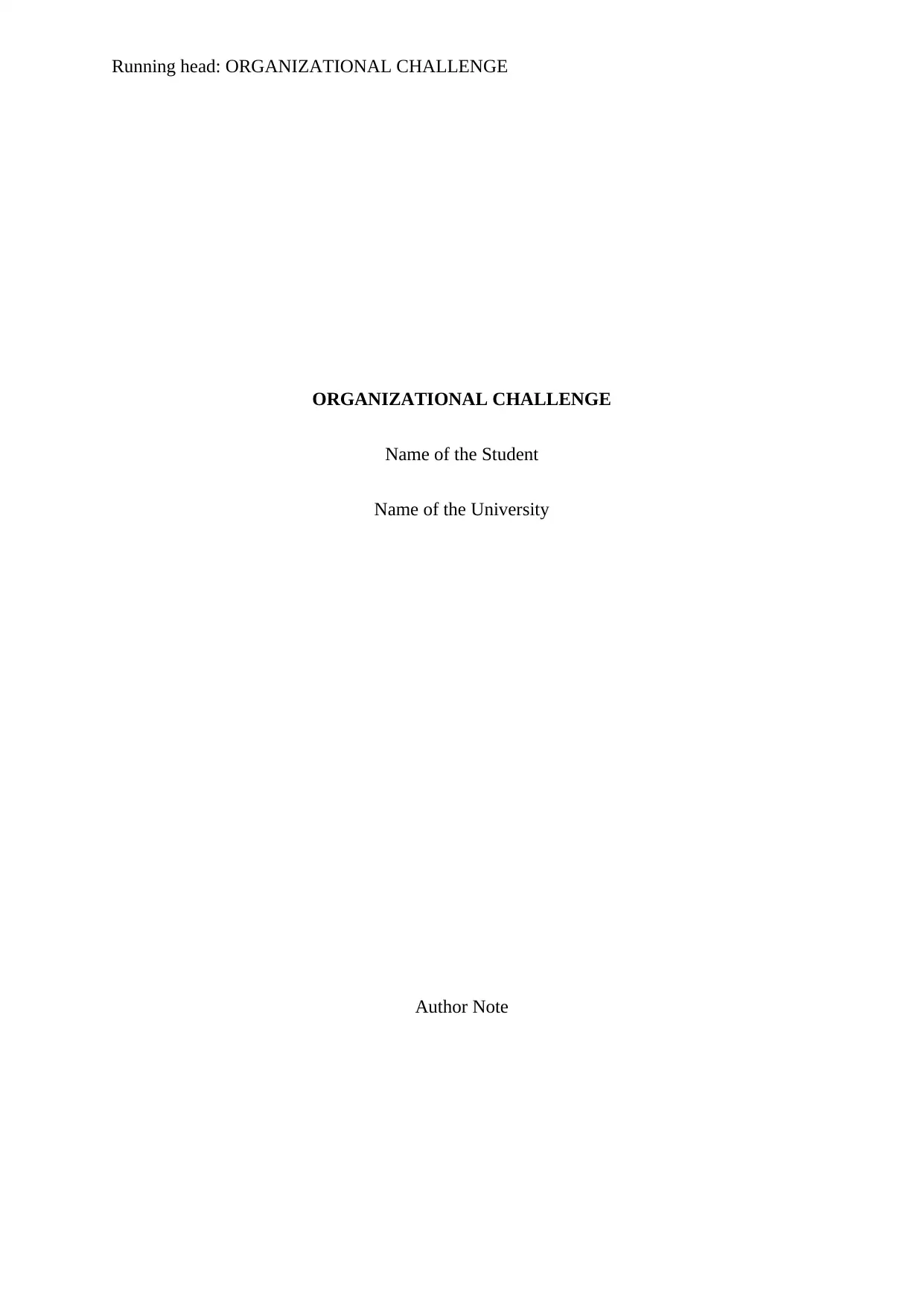
Running head: ORGANIZATIONAL CHALLENGE
ORGANIZATIONAL CHALLENGE
Name of the Student
Name of the University
Author Note
ORGANIZATIONAL CHALLENGE
Name of the Student
Name of the University
Author Note
Secure Best Marks with AI Grader
Need help grading? Try our AI Grader for instant feedback on your assignments.
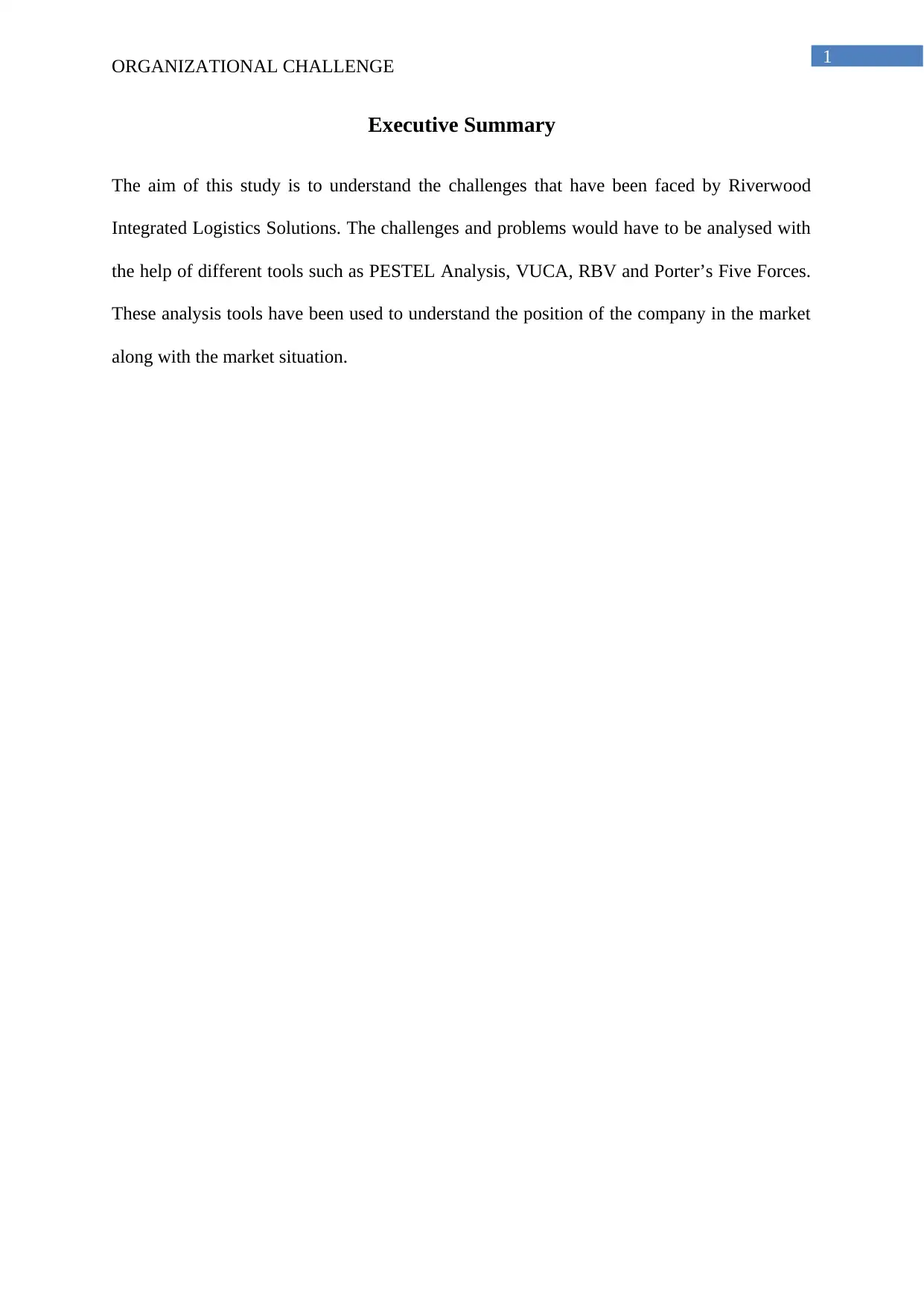
1
ORGANIZATIONAL CHALLENGE
Executive Summary
The aim of this study is to understand the challenges that have been faced by Riverwood
Integrated Logistics Solutions. The challenges and problems would have to be analysed with
the help of different tools such as PESTEL Analysis, VUCA, RBV and Porter’s Five Forces.
These analysis tools have been used to understand the position of the company in the market
along with the market situation.
ORGANIZATIONAL CHALLENGE
Executive Summary
The aim of this study is to understand the challenges that have been faced by Riverwood
Integrated Logistics Solutions. The challenges and problems would have to be analysed with
the help of different tools such as PESTEL Analysis, VUCA, RBV and Porter’s Five Forces.
These analysis tools have been used to understand the position of the company in the market
along with the market situation.
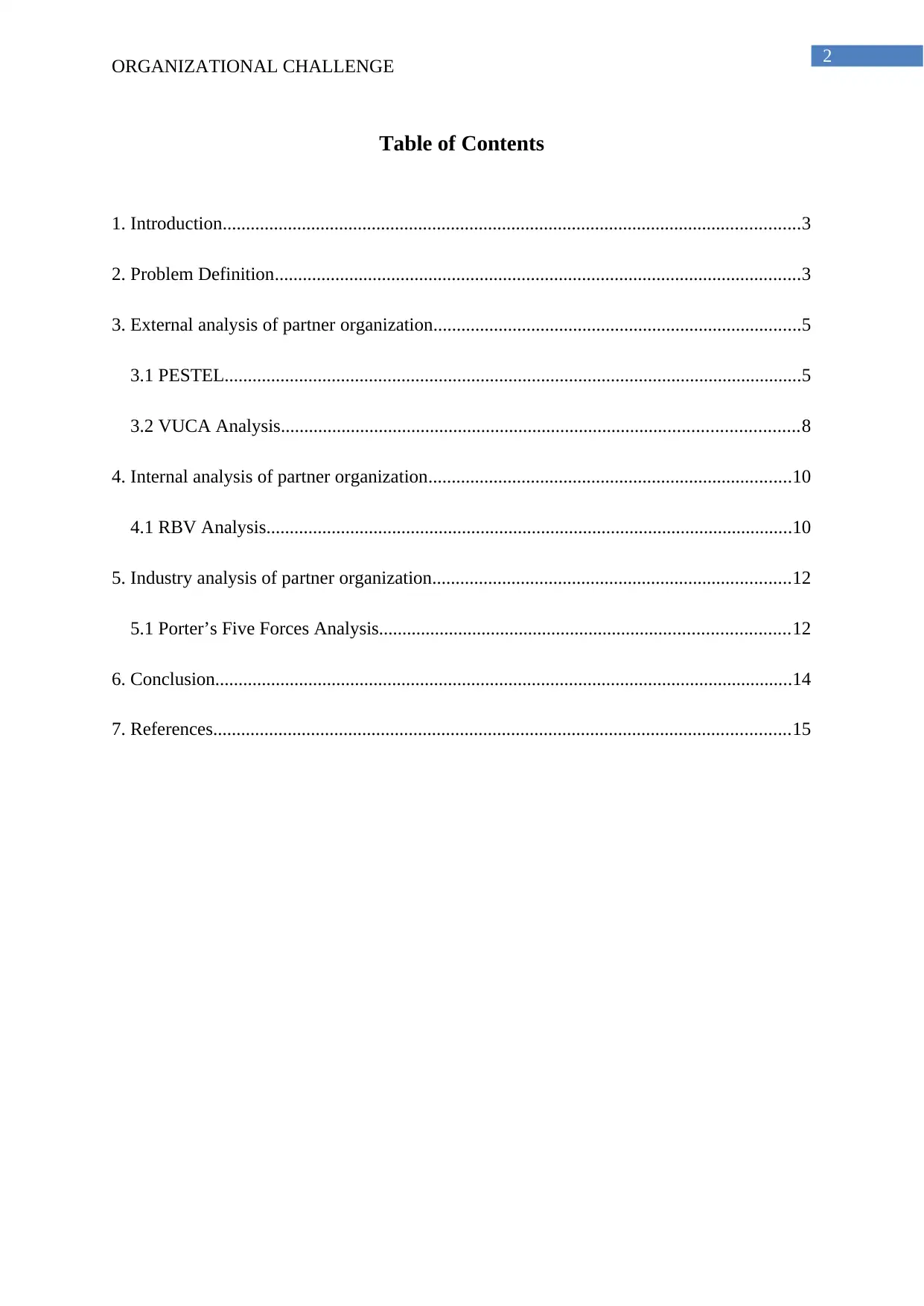
2
ORGANIZATIONAL CHALLENGE
Table of Contents
1. Introduction............................................................................................................................3
2. Problem Definition.................................................................................................................3
3. External analysis of partner organization...............................................................................5
3.1 PESTEL............................................................................................................................5
3.2 VUCA Analysis...............................................................................................................8
4. Internal analysis of partner organization..............................................................................10
4.1 RBV Analysis.................................................................................................................10
5. Industry analysis of partner organization.............................................................................12
5.1 Porter’s Five Forces Analysis........................................................................................12
6. Conclusion............................................................................................................................14
7. References............................................................................................................................15
ORGANIZATIONAL CHALLENGE
Table of Contents
1. Introduction............................................................................................................................3
2. Problem Definition.................................................................................................................3
3. External analysis of partner organization...............................................................................5
3.1 PESTEL............................................................................................................................5
3.2 VUCA Analysis...............................................................................................................8
4. Internal analysis of partner organization..............................................................................10
4.1 RBV Analysis.................................................................................................................10
5. Industry analysis of partner organization.............................................................................12
5.1 Porter’s Five Forces Analysis........................................................................................12
6. Conclusion............................................................................................................................14
7. References............................................................................................................................15
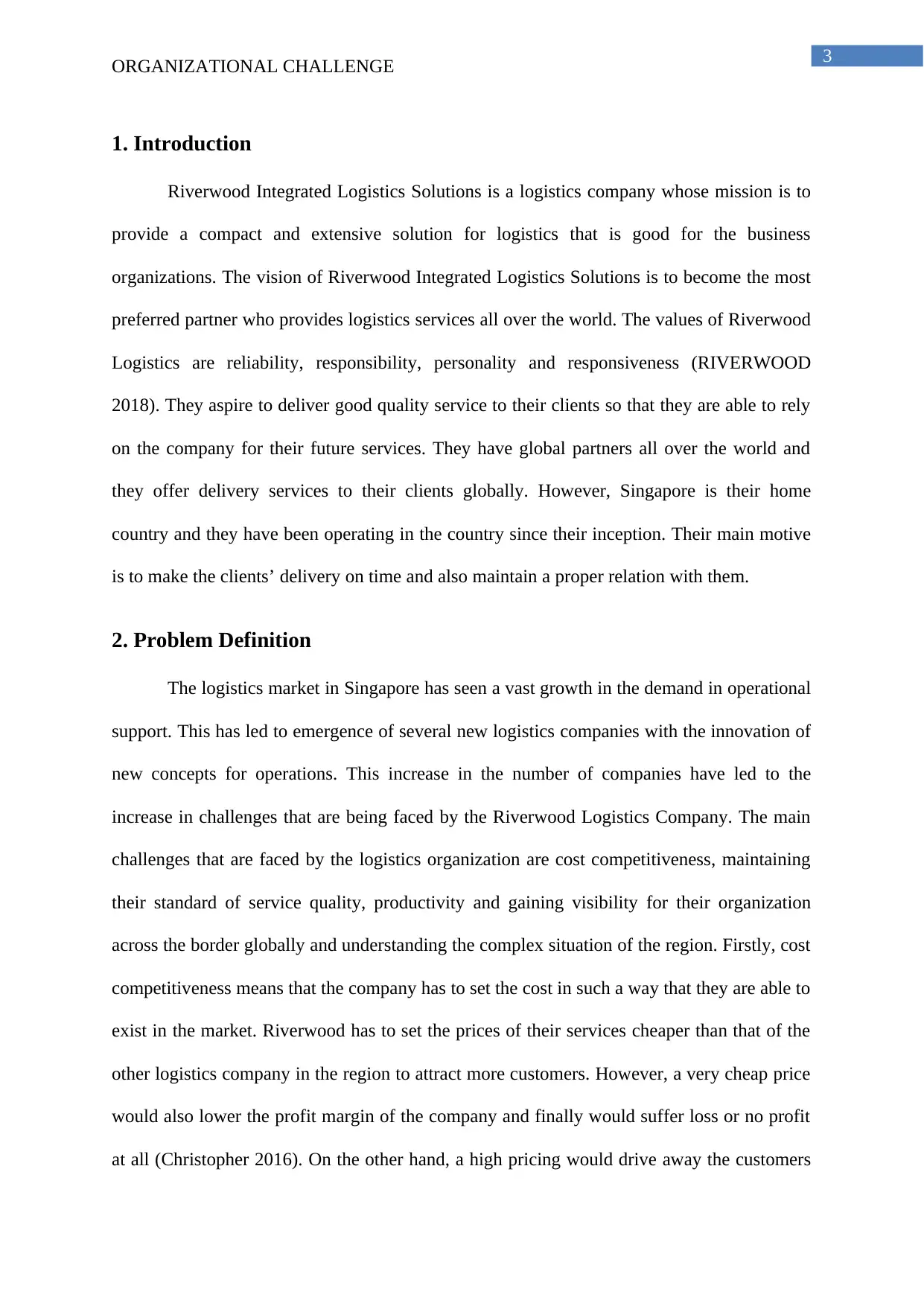
3
ORGANIZATIONAL CHALLENGE
1. Introduction
Riverwood Integrated Logistics Solutions is a logistics company whose mission is to
provide a compact and extensive solution for logistics that is good for the business
organizations. The vision of Riverwood Integrated Logistics Solutions is to become the most
preferred partner who provides logistics services all over the world. The values of Riverwood
Logistics are reliability, responsibility, personality and responsiveness (RIVERWOOD
2018). They aspire to deliver good quality service to their clients so that they are able to rely
on the company for their future services. They have global partners all over the world and
they offer delivery services to their clients globally. However, Singapore is their home
country and they have been operating in the country since their inception. Their main motive
is to make the clients’ delivery on time and also maintain a proper relation with them.
2. Problem Definition
The logistics market in Singapore has seen a vast growth in the demand in operational
support. This has led to emergence of several new logistics companies with the innovation of
new concepts for operations. This increase in the number of companies have led to the
increase in challenges that are being faced by the Riverwood Logistics Company. The main
challenges that are faced by the logistics organization are cost competitiveness, maintaining
their standard of service quality, productivity and gaining visibility for their organization
across the border globally and understanding the complex situation of the region. Firstly, cost
competitiveness means that the company has to set the cost in such a way that they are able to
exist in the market. Riverwood has to set the prices of their services cheaper than that of the
other logistics company in the region to attract more customers. However, a very cheap price
would also lower the profit margin of the company and finally would suffer loss or no profit
at all (Christopher 2016). On the other hand, a high pricing would drive away the customers
ORGANIZATIONAL CHALLENGE
1. Introduction
Riverwood Integrated Logistics Solutions is a logistics company whose mission is to
provide a compact and extensive solution for logistics that is good for the business
organizations. The vision of Riverwood Integrated Logistics Solutions is to become the most
preferred partner who provides logistics services all over the world. The values of Riverwood
Logistics are reliability, responsibility, personality and responsiveness (RIVERWOOD
2018). They aspire to deliver good quality service to their clients so that they are able to rely
on the company for their future services. They have global partners all over the world and
they offer delivery services to their clients globally. However, Singapore is their home
country and they have been operating in the country since their inception. Their main motive
is to make the clients’ delivery on time and also maintain a proper relation with them.
2. Problem Definition
The logistics market in Singapore has seen a vast growth in the demand in operational
support. This has led to emergence of several new logistics companies with the innovation of
new concepts for operations. This increase in the number of companies have led to the
increase in challenges that are being faced by the Riverwood Logistics Company. The main
challenges that are faced by the logistics organization are cost competitiveness, maintaining
their standard of service quality, productivity and gaining visibility for their organization
across the border globally and understanding the complex situation of the region. Firstly, cost
competitiveness means that the company has to set the cost in such a way that they are able to
exist in the market. Riverwood has to set the prices of their services cheaper than that of the
other logistics company in the region to attract more customers. However, a very cheap price
would also lower the profit margin of the company and finally would suffer loss or no profit
at all (Christopher 2016). On the other hand, a high pricing would drive away the customers
Secure Best Marks with AI Grader
Need help grading? Try our AI Grader for instant feedback on your assignments.
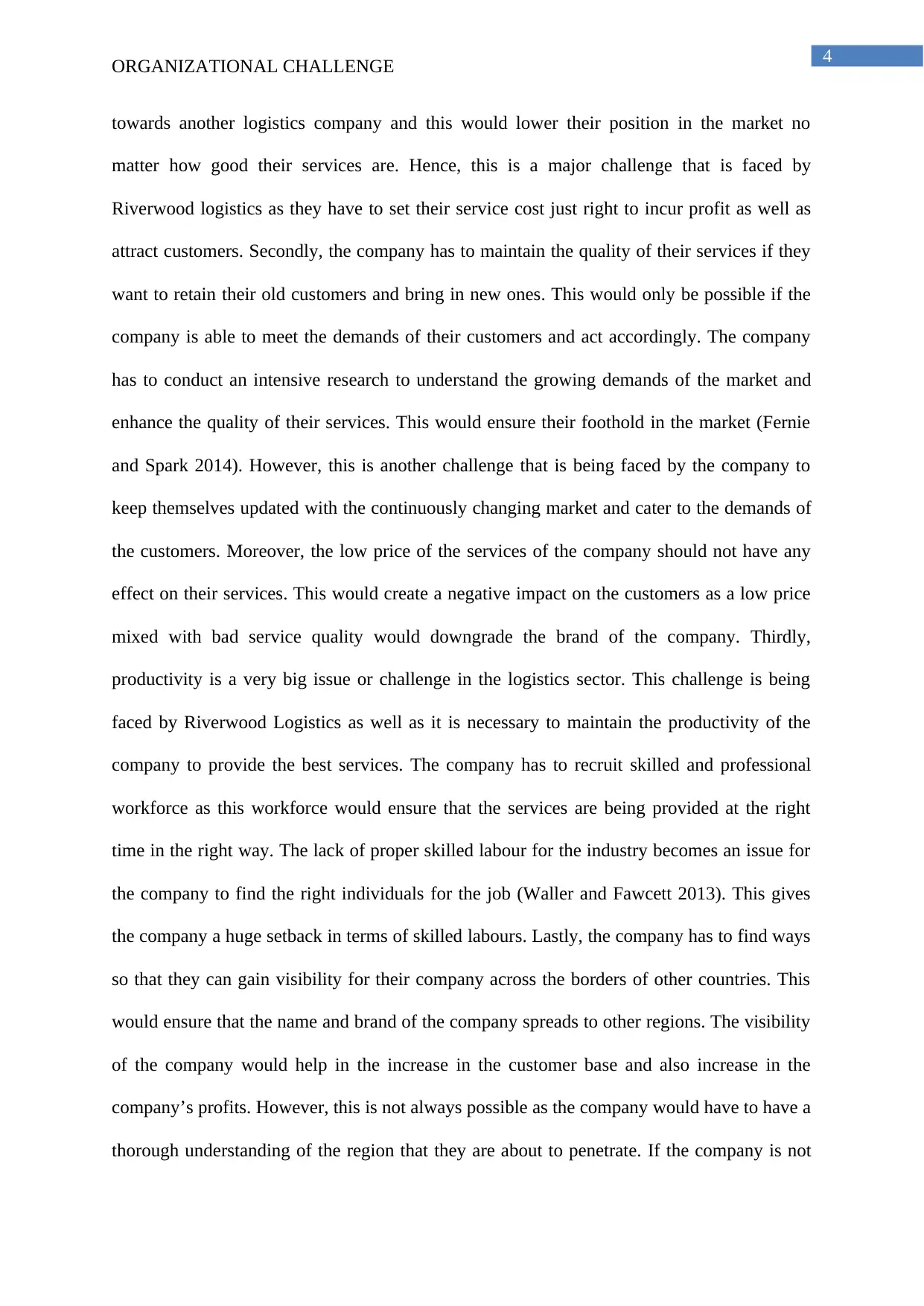
4
ORGANIZATIONAL CHALLENGE
towards another logistics company and this would lower their position in the market no
matter how good their services are. Hence, this is a major challenge that is faced by
Riverwood logistics as they have to set their service cost just right to incur profit as well as
attract customers. Secondly, the company has to maintain the quality of their services if they
want to retain their old customers and bring in new ones. This would only be possible if the
company is able to meet the demands of their customers and act accordingly. The company
has to conduct an intensive research to understand the growing demands of the market and
enhance the quality of their services. This would ensure their foothold in the market (Fernie
and Spark 2014). However, this is another challenge that is being faced by the company to
keep themselves updated with the continuously changing market and cater to the demands of
the customers. Moreover, the low price of the services of the company should not have any
effect on their services. This would create a negative impact on the customers as a low price
mixed with bad service quality would downgrade the brand of the company. Thirdly,
productivity is a very big issue or challenge in the logistics sector. This challenge is being
faced by Riverwood Logistics as well as it is necessary to maintain the productivity of the
company to provide the best services. The company has to recruit skilled and professional
workforce as this workforce would ensure that the services are being provided at the right
time in the right way. The lack of proper skilled labour for the industry becomes an issue for
the company to find the right individuals for the job (Waller and Fawcett 2013). This gives
the company a huge setback in terms of skilled labours. Lastly, the company has to find ways
so that they can gain visibility for their company across the borders of other countries. This
would ensure that the name and brand of the company spreads to other regions. The visibility
of the company would help in the increase in the customer base and also increase in the
company’s profits. However, this is not always possible as the company would have to have a
thorough understanding of the region that they are about to penetrate. If the company is not
ORGANIZATIONAL CHALLENGE
towards another logistics company and this would lower their position in the market no
matter how good their services are. Hence, this is a major challenge that is faced by
Riverwood logistics as they have to set their service cost just right to incur profit as well as
attract customers. Secondly, the company has to maintain the quality of their services if they
want to retain their old customers and bring in new ones. This would only be possible if the
company is able to meet the demands of their customers and act accordingly. The company
has to conduct an intensive research to understand the growing demands of the market and
enhance the quality of their services. This would ensure their foothold in the market (Fernie
and Spark 2014). However, this is another challenge that is being faced by the company to
keep themselves updated with the continuously changing market and cater to the demands of
the customers. Moreover, the low price of the services of the company should not have any
effect on their services. This would create a negative impact on the customers as a low price
mixed with bad service quality would downgrade the brand of the company. Thirdly,
productivity is a very big issue or challenge in the logistics sector. This challenge is being
faced by Riverwood Logistics as well as it is necessary to maintain the productivity of the
company to provide the best services. The company has to recruit skilled and professional
workforce as this workforce would ensure that the services are being provided at the right
time in the right way. The lack of proper skilled labour for the industry becomes an issue for
the company to find the right individuals for the job (Waller and Fawcett 2013). This gives
the company a huge setback in terms of skilled labours. Lastly, the company has to find ways
so that they can gain visibility for their company across the borders of other countries. This
would ensure that the name and brand of the company spreads to other regions. The visibility
of the company would help in the increase in the customer base and also increase in the
company’s profits. However, this is not always possible as the company would have to have a
thorough understanding of the region that they are about to penetrate. If the company is not
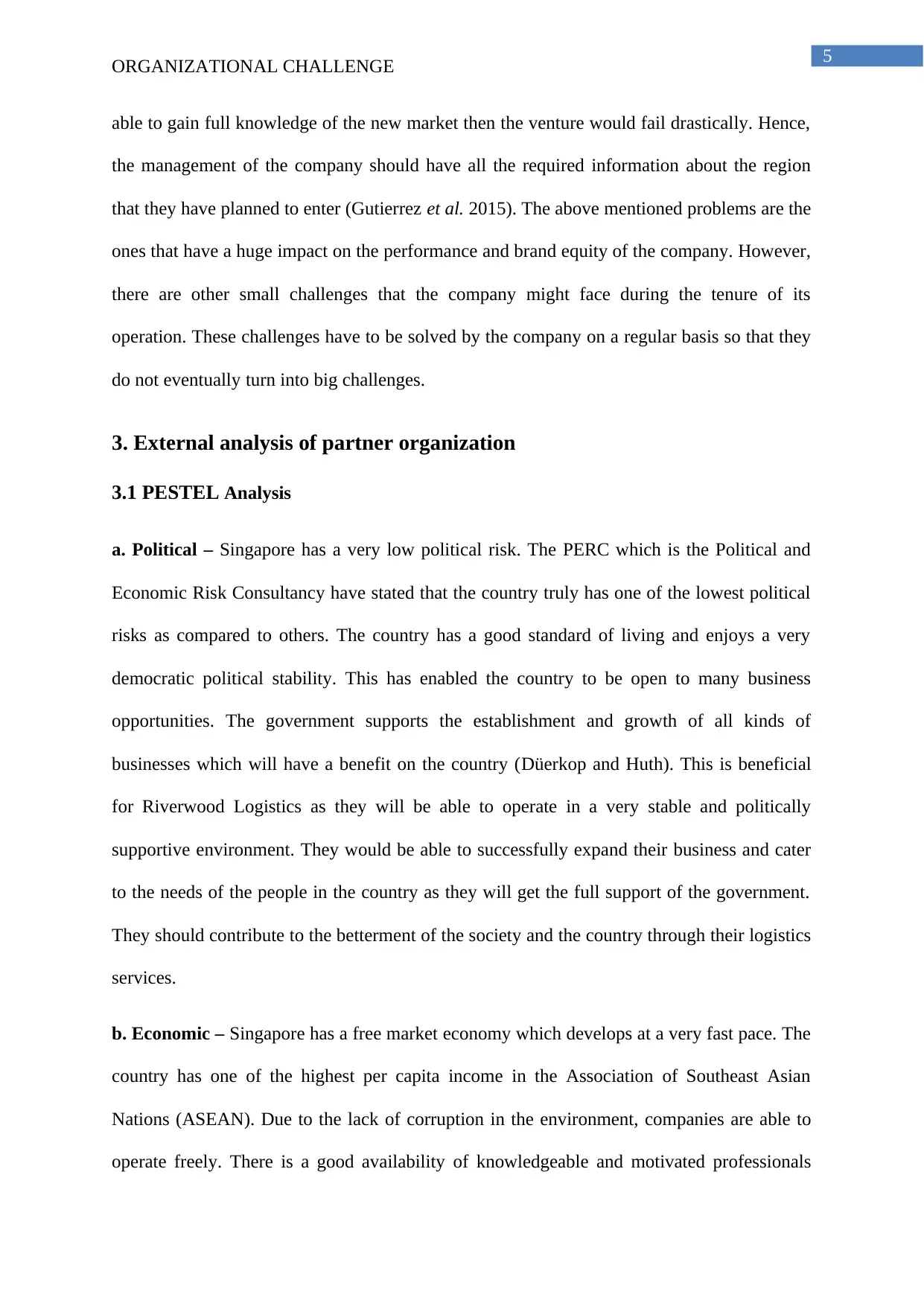
5
ORGANIZATIONAL CHALLENGE
able to gain full knowledge of the new market then the venture would fail drastically. Hence,
the management of the company should have all the required information about the region
that they have planned to enter (Gutierrez et al. 2015). The above mentioned problems are the
ones that have a huge impact on the performance and brand equity of the company. However,
there are other small challenges that the company might face during the tenure of its
operation. These challenges have to be solved by the company on a regular basis so that they
do not eventually turn into big challenges.
3. External analysis of partner organization
3.1 PESTEL Analysis
a. Political – Singapore has a very low political risk. The PERC which is the Political and
Economic Risk Consultancy have stated that the country truly has one of the lowest political
risks as compared to others. The country has a good standard of living and enjoys a very
democratic political stability. This has enabled the country to be open to many business
opportunities. The government supports the establishment and growth of all kinds of
businesses which will have a benefit on the country (Düerkop and Huth). This is beneficial
for Riverwood Logistics as they will be able to operate in a very stable and politically
supportive environment. They would be able to successfully expand their business and cater
to the needs of the people in the country as they will get the full support of the government.
They should contribute to the betterment of the society and the country through their logistics
services.
b. Economic – Singapore has a free market economy which develops at a very fast pace. The
country has one of the highest per capita income in the Association of Southeast Asian
Nations (ASEAN). Due to the lack of corruption in the environment, companies are able to
operate freely. There is a good availability of knowledgeable and motivated professionals
ORGANIZATIONAL CHALLENGE
able to gain full knowledge of the new market then the venture would fail drastically. Hence,
the management of the company should have all the required information about the region
that they have planned to enter (Gutierrez et al. 2015). The above mentioned problems are the
ones that have a huge impact on the performance and brand equity of the company. However,
there are other small challenges that the company might face during the tenure of its
operation. These challenges have to be solved by the company on a regular basis so that they
do not eventually turn into big challenges.
3. External analysis of partner organization
3.1 PESTEL Analysis
a. Political – Singapore has a very low political risk. The PERC which is the Political and
Economic Risk Consultancy have stated that the country truly has one of the lowest political
risks as compared to others. The country has a good standard of living and enjoys a very
democratic political stability. This has enabled the country to be open to many business
opportunities. The government supports the establishment and growth of all kinds of
businesses which will have a benefit on the country (Düerkop and Huth). This is beneficial
for Riverwood Logistics as they will be able to operate in a very stable and politically
supportive environment. They would be able to successfully expand their business and cater
to the needs of the people in the country as they will get the full support of the government.
They should contribute to the betterment of the society and the country through their logistics
services.
b. Economic – Singapore has a free market economy which develops at a very fast pace. The
country has one of the highest per capita income in the Association of Southeast Asian
Nations (ASEAN). Due to the lack of corruption in the environment, companies are able to
operate freely. There is a good availability of knowledgeable and motivated professionals
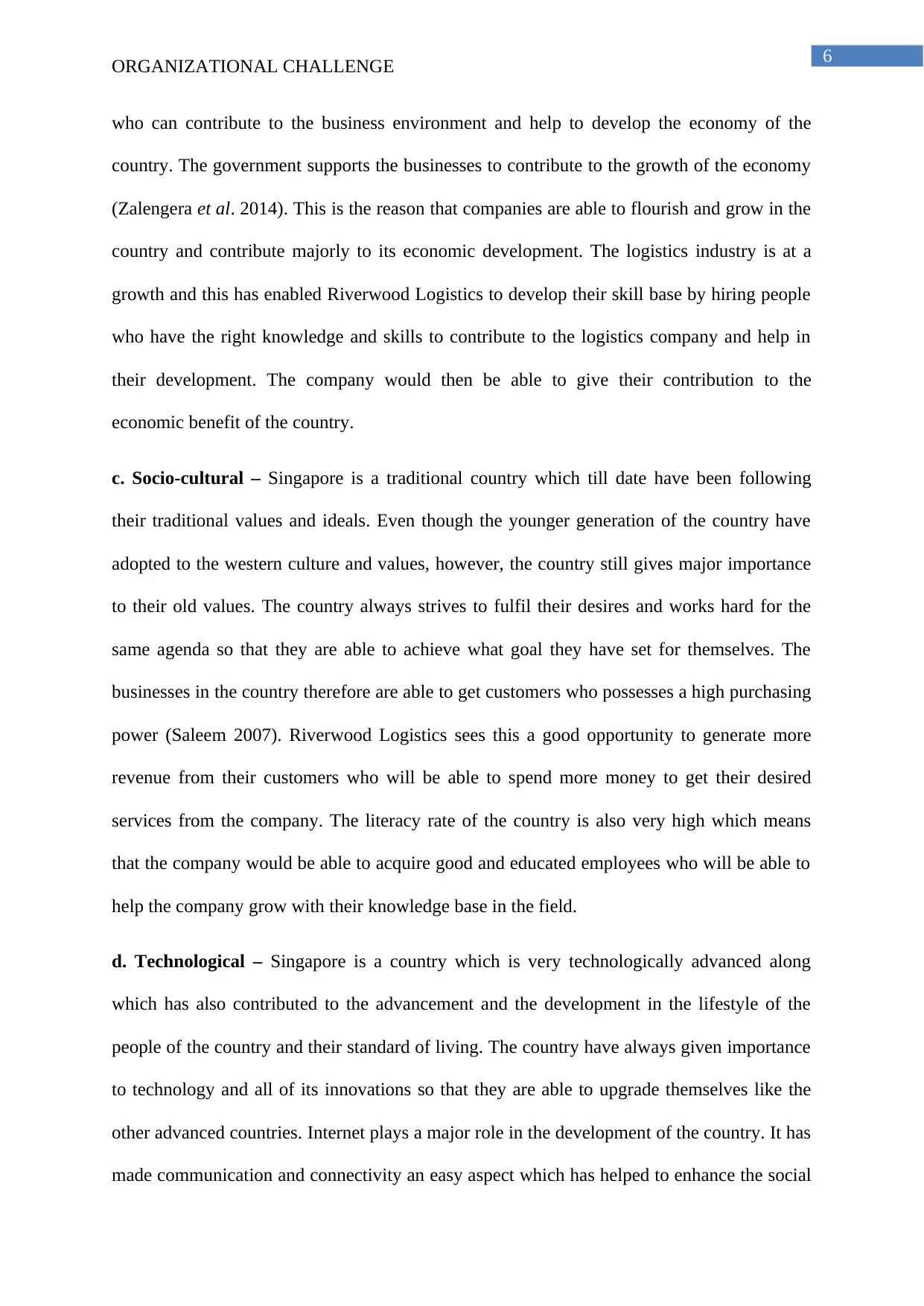
6
ORGANIZATIONAL CHALLENGE
who can contribute to the business environment and help to develop the economy of the
country. The government supports the businesses to contribute to the growth of the economy
(Zalengera et al. 2014). This is the reason that companies are able to flourish and grow in the
country and contribute majorly to its economic development. The logistics industry is at a
growth and this has enabled Riverwood Logistics to develop their skill base by hiring people
who have the right knowledge and skills to contribute to the logistics company and help in
their development. The company would then be able to give their contribution to the
economic benefit of the country.
c. Socio-cultural – Singapore is a traditional country which till date have been following
their traditional values and ideals. Even though the younger generation of the country have
adopted to the western culture and values, however, the country still gives major importance
to their old values. The country always strives to fulfil their desires and works hard for the
same agenda so that they are able to achieve what goal they have set for themselves. The
businesses in the country therefore are able to get customers who possesses a high purchasing
power (Saleem 2007). Riverwood Logistics sees this a good opportunity to generate more
revenue from their customers who will be able to spend more money to get their desired
services from the company. The literacy rate of the country is also very high which means
that the company would be able to acquire good and educated employees who will be able to
help the company grow with their knowledge base in the field.
d. Technological – Singapore is a country which is very technologically advanced along
which has also contributed to the advancement and the development in the lifestyle of the
people of the country and their standard of living. The country have always given importance
to technology and all of its innovations so that they are able to upgrade themselves like the
other advanced countries. Internet plays a major role in the development of the country. It has
made communication and connectivity an easy aspect which has helped to enhance the social
ORGANIZATIONAL CHALLENGE
who can contribute to the business environment and help to develop the economy of the
country. The government supports the businesses to contribute to the growth of the economy
(Zalengera et al. 2014). This is the reason that companies are able to flourish and grow in the
country and contribute majorly to its economic development. The logistics industry is at a
growth and this has enabled Riverwood Logistics to develop their skill base by hiring people
who have the right knowledge and skills to contribute to the logistics company and help in
their development. The company would then be able to give their contribution to the
economic benefit of the country.
c. Socio-cultural – Singapore is a traditional country which till date have been following
their traditional values and ideals. Even though the younger generation of the country have
adopted to the western culture and values, however, the country still gives major importance
to their old values. The country always strives to fulfil their desires and works hard for the
same agenda so that they are able to achieve what goal they have set for themselves. The
businesses in the country therefore are able to get customers who possesses a high purchasing
power (Saleem 2007). Riverwood Logistics sees this a good opportunity to generate more
revenue from their customers who will be able to spend more money to get their desired
services from the company. The literacy rate of the country is also very high which means
that the company would be able to acquire good and educated employees who will be able to
help the company grow with their knowledge base in the field.
d. Technological – Singapore is a country which is very technologically advanced along
which has also contributed to the advancement and the development in the lifestyle of the
people of the country and their standard of living. The country have always given importance
to technology and all of its innovations so that they are able to upgrade themselves like the
other advanced countries. Internet plays a major role in the development of the country. It has
made communication and connectivity an easy aspect which has helped to enhance the social
Paraphrase This Document
Need a fresh take? Get an instant paraphrase of this document with our AI Paraphraser
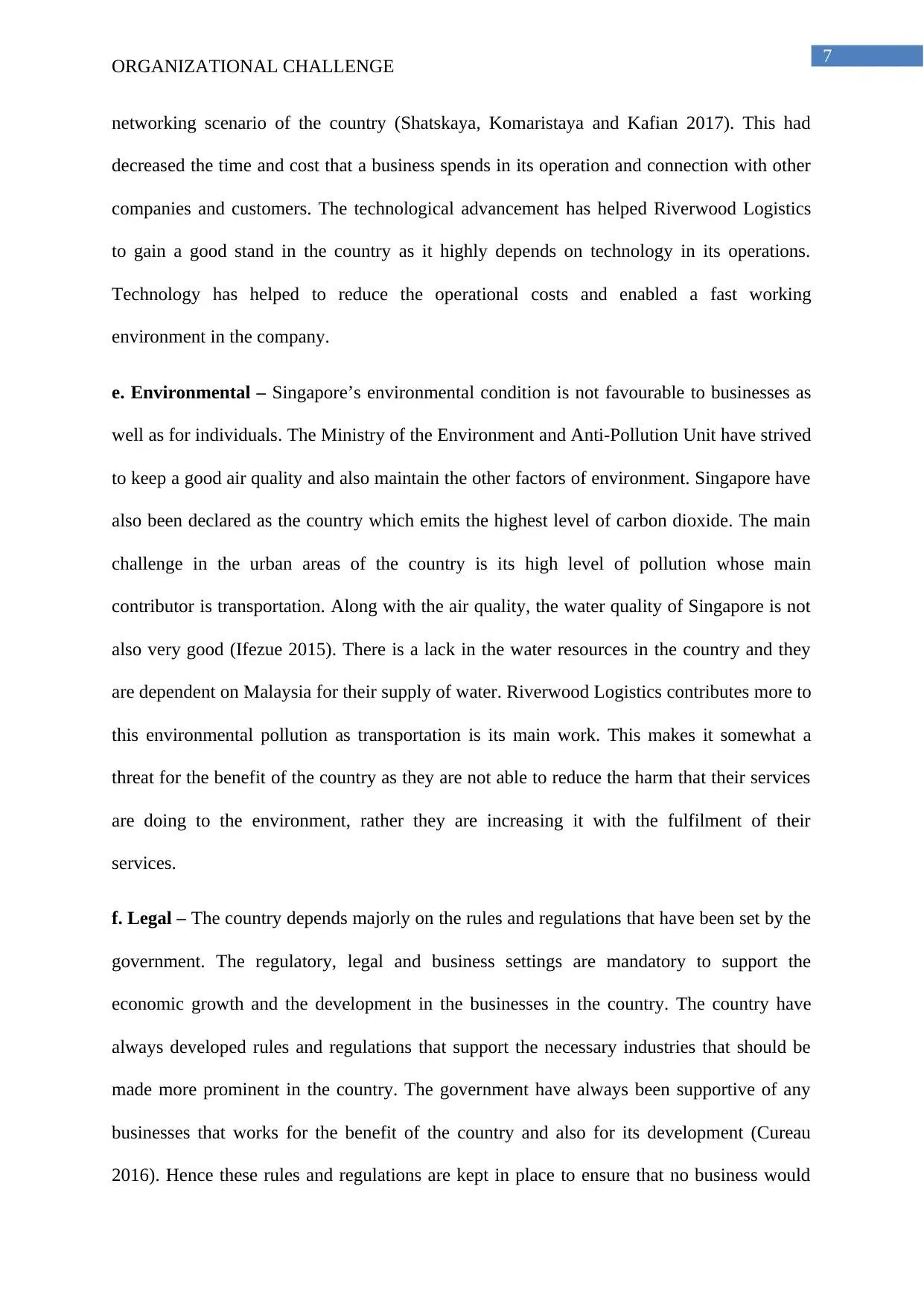
7
ORGANIZATIONAL CHALLENGE
networking scenario of the country (Shatskaya, Komaristaya and Kafian 2017). This had
decreased the time and cost that a business spends in its operation and connection with other
companies and customers. The technological advancement has helped Riverwood Logistics
to gain a good stand in the country as it highly depends on technology in its operations.
Technology has helped to reduce the operational costs and enabled a fast working
environment in the company.
e. Environmental – Singapore’s environmental condition is not favourable to businesses as
well as for individuals. The Ministry of the Environment and Anti-Pollution Unit have strived
to keep a good air quality and also maintain the other factors of environment. Singapore have
also been declared as the country which emits the highest level of carbon dioxide. The main
challenge in the urban areas of the country is its high level of pollution whose main
contributor is transportation. Along with the air quality, the water quality of Singapore is not
also very good (Ifezue 2015). There is a lack in the water resources in the country and they
are dependent on Malaysia for their supply of water. Riverwood Logistics contributes more to
this environmental pollution as transportation is its main work. This makes it somewhat a
threat for the benefit of the country as they are not able to reduce the harm that their services
are doing to the environment, rather they are increasing it with the fulfilment of their
services.
f. Legal – The country depends majorly on the rules and regulations that have been set by the
government. The regulatory, legal and business settings are mandatory to support the
economic growth and the development in the businesses in the country. The country have
always developed rules and regulations that support the necessary industries that should be
made more prominent in the country. The government have always been supportive of any
businesses that works for the benefit of the country and also for its development (Cureau
2016). Hence these rules and regulations are kept in place to ensure that no business would
ORGANIZATIONAL CHALLENGE
networking scenario of the country (Shatskaya, Komaristaya and Kafian 2017). This had
decreased the time and cost that a business spends in its operation and connection with other
companies and customers. The technological advancement has helped Riverwood Logistics
to gain a good stand in the country as it highly depends on technology in its operations.
Technology has helped to reduce the operational costs and enabled a fast working
environment in the company.
e. Environmental – Singapore’s environmental condition is not favourable to businesses as
well as for individuals. The Ministry of the Environment and Anti-Pollution Unit have strived
to keep a good air quality and also maintain the other factors of environment. Singapore have
also been declared as the country which emits the highest level of carbon dioxide. The main
challenge in the urban areas of the country is its high level of pollution whose main
contributor is transportation. Along with the air quality, the water quality of Singapore is not
also very good (Ifezue 2015). There is a lack in the water resources in the country and they
are dependent on Malaysia for their supply of water. Riverwood Logistics contributes more to
this environmental pollution as transportation is its main work. This makes it somewhat a
threat for the benefit of the country as they are not able to reduce the harm that their services
are doing to the environment, rather they are increasing it with the fulfilment of their
services.
f. Legal – The country depends majorly on the rules and regulations that have been set by the
government. The regulatory, legal and business settings are mandatory to support the
economic growth and the development in the businesses in the country. The country have
always developed rules and regulations that support the necessary industries that should be
made more prominent in the country. The government have always been supportive of any
businesses that works for the benefit of the country and also for its development (Cureau
2016). Hence these rules and regulations are kept in place to ensure that no business would
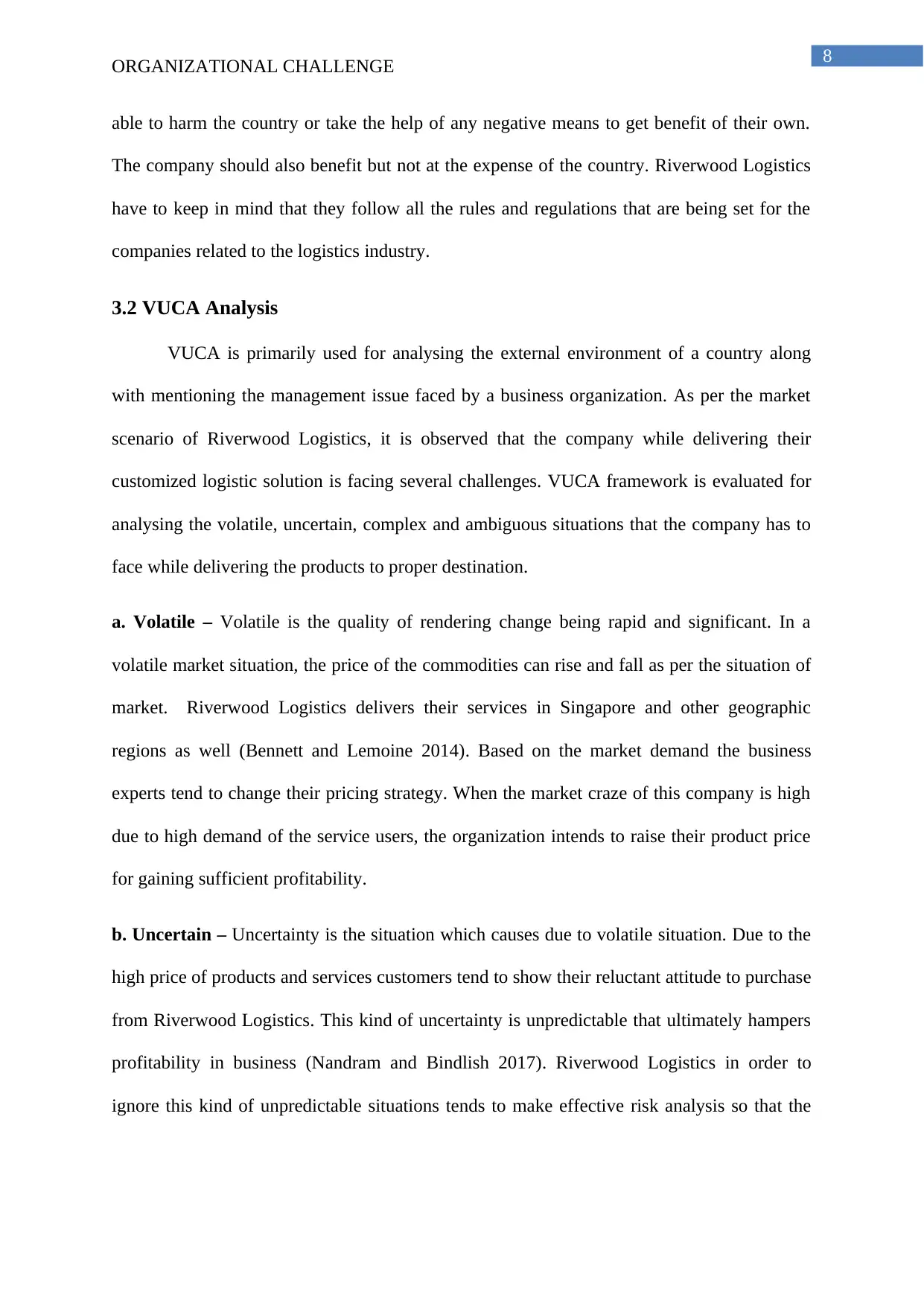
8
ORGANIZATIONAL CHALLENGE
able to harm the country or take the help of any negative means to get benefit of their own.
The company should also benefit but not at the expense of the country. Riverwood Logistics
have to keep in mind that they follow all the rules and regulations that are being set for the
companies related to the logistics industry.
3.2 VUCA Analysis
VUCA is primarily used for analysing the external environment of a country along
with mentioning the management issue faced by a business organization. As per the market
scenario of Riverwood Logistics, it is observed that the company while delivering their
customized logistic solution is facing several challenges. VUCA framework is evaluated for
analysing the volatile, uncertain, complex and ambiguous situations that the company has to
face while delivering the products to proper destination.
a. Volatile – Volatile is the quality of rendering change being rapid and significant. In a
volatile market situation, the price of the commodities can rise and fall as per the situation of
market. Riverwood Logistics delivers their services in Singapore and other geographic
regions as well (Bennett and Lemoine 2014). Based on the market demand the business
experts tend to change their pricing strategy. When the market craze of this company is high
due to high demand of the service users, the organization intends to raise their product price
for gaining sufficient profitability.
b. Uncertain – Uncertainty is the situation which causes due to volatile situation. Due to the
high price of products and services customers tend to show their reluctant attitude to purchase
from Riverwood Logistics. This kind of uncertainty is unpredictable that ultimately hampers
profitability in business (Nandram and Bindlish 2017). Riverwood Logistics in order to
ignore this kind of unpredictable situations tends to make effective risk analysis so that the
ORGANIZATIONAL CHALLENGE
able to harm the country or take the help of any negative means to get benefit of their own.
The company should also benefit but not at the expense of the country. Riverwood Logistics
have to keep in mind that they follow all the rules and regulations that are being set for the
companies related to the logistics industry.
3.2 VUCA Analysis
VUCA is primarily used for analysing the external environment of a country along
with mentioning the management issue faced by a business organization. As per the market
scenario of Riverwood Logistics, it is observed that the company while delivering their
customized logistic solution is facing several challenges. VUCA framework is evaluated for
analysing the volatile, uncertain, complex and ambiguous situations that the company has to
face while delivering the products to proper destination.
a. Volatile – Volatile is the quality of rendering change being rapid and significant. In a
volatile market situation, the price of the commodities can rise and fall as per the situation of
market. Riverwood Logistics delivers their services in Singapore and other geographic
regions as well (Bennett and Lemoine 2014). Based on the market demand the business
experts tend to change their pricing strategy. When the market craze of this company is high
due to high demand of the service users, the organization intends to raise their product price
for gaining sufficient profitability.
b. Uncertain – Uncertainty is the situation which causes due to volatile situation. Due to the
high price of products and services customers tend to show their reluctant attitude to purchase
from Riverwood Logistics. This kind of uncertainty is unpredictable that ultimately hampers
profitability in business (Nandram and Bindlish 2017). Riverwood Logistics in order to
ignore this kind of unpredictable situations tends to make effective risk analysis so that the
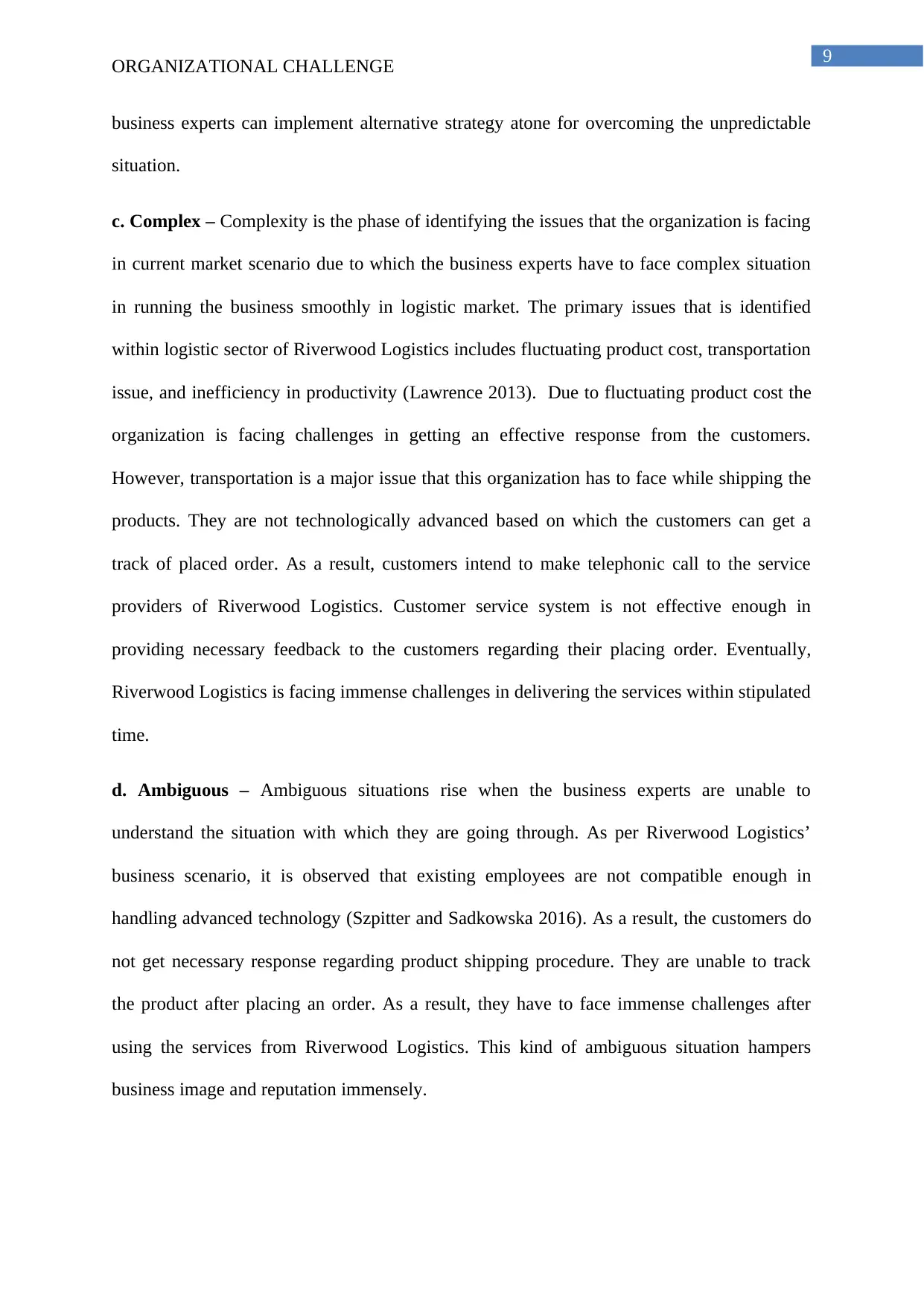
9
ORGANIZATIONAL CHALLENGE
business experts can implement alternative strategy atone for overcoming the unpredictable
situation.
c. Complex – Complexity is the phase of identifying the issues that the organization is facing
in current market scenario due to which the business experts have to face complex situation
in running the business smoothly in logistic market. The primary issues that is identified
within logistic sector of Riverwood Logistics includes fluctuating product cost, transportation
issue, and inefficiency in productivity (Lawrence 2013). Due to fluctuating product cost the
organization is facing challenges in getting an effective response from the customers.
However, transportation is a major issue that this organization has to face while shipping the
products. They are not technologically advanced based on which the customers can get a
track of placed order. As a result, customers intend to make telephonic call to the service
providers of Riverwood Logistics. Customer service system is not effective enough in
providing necessary feedback to the customers regarding their placing order. Eventually,
Riverwood Logistics is facing immense challenges in delivering the services within stipulated
time.
d. Ambiguous – Ambiguous situations rise when the business experts are unable to
understand the situation with which they are going through. As per Riverwood Logistics’
business scenario, it is observed that existing employees are not compatible enough in
handling advanced technology (Szpitter and Sadkowska 2016). As a result, the customers do
not get necessary response regarding product shipping procedure. They are unable to track
the product after placing an order. As a result, they have to face immense challenges after
using the services from Riverwood Logistics. This kind of ambiguous situation hampers
business image and reputation immensely.
ORGANIZATIONAL CHALLENGE
business experts can implement alternative strategy atone for overcoming the unpredictable
situation.
c. Complex – Complexity is the phase of identifying the issues that the organization is facing
in current market scenario due to which the business experts have to face complex situation
in running the business smoothly in logistic market. The primary issues that is identified
within logistic sector of Riverwood Logistics includes fluctuating product cost, transportation
issue, and inefficiency in productivity (Lawrence 2013). Due to fluctuating product cost the
organization is facing challenges in getting an effective response from the customers.
However, transportation is a major issue that this organization has to face while shipping the
products. They are not technologically advanced based on which the customers can get a
track of placed order. As a result, customers intend to make telephonic call to the service
providers of Riverwood Logistics. Customer service system is not effective enough in
providing necessary feedback to the customers regarding their placing order. Eventually,
Riverwood Logistics is facing immense challenges in delivering the services within stipulated
time.
d. Ambiguous – Ambiguous situations rise when the business experts are unable to
understand the situation with which they are going through. As per Riverwood Logistics’
business scenario, it is observed that existing employees are not compatible enough in
handling advanced technology (Szpitter and Sadkowska 2016). As a result, the customers do
not get necessary response regarding product shipping procedure. They are unable to track
the product after placing an order. As a result, they have to face immense challenges after
using the services from Riverwood Logistics. This kind of ambiguous situation hampers
business image and reputation immensely.
Secure Best Marks with AI Grader
Need help grading? Try our AI Grader for instant feedback on your assignments.
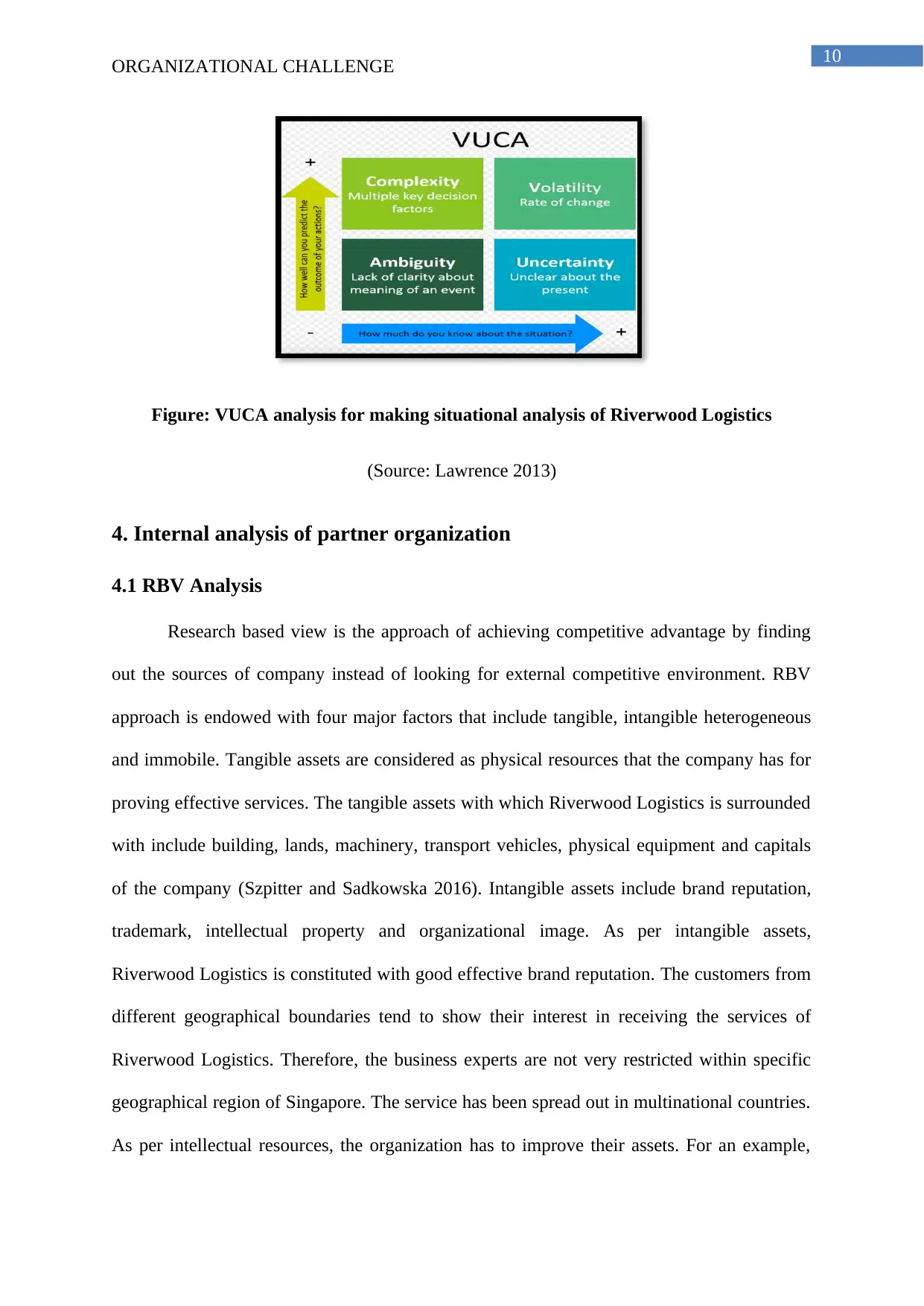
10
ORGANIZATIONAL CHALLENGE
Figure: VUCA analysis for making situational analysis of Riverwood Logistics
(Source: Lawrence 2013)
4. Internal analysis of partner organization
4.1 RBV Analysis
Research based view is the approach of achieving competitive advantage by finding
out the sources of company instead of looking for external competitive environment. RBV
approach is endowed with four major factors that include tangible, intangible heterogeneous
and immobile. Tangible assets are considered as physical resources that the company has for
proving effective services. The tangible assets with which Riverwood Logistics is surrounded
with include building, lands, machinery, transport vehicles, physical equipment and capitals
of the company (Szpitter and Sadkowska 2016). Intangible assets include brand reputation,
trademark, intellectual property and organizational image. As per intangible assets,
Riverwood Logistics is constituted with good effective brand reputation. The customers from
different geographical boundaries tend to show their interest in receiving the services of
Riverwood Logistics. Therefore, the business experts are not very restricted within specific
geographical region of Singapore. The service has been spread out in multinational countries.
As per intellectual resources, the organization has to improve their assets. For an example,
ORGANIZATIONAL CHALLENGE
Figure: VUCA analysis for making situational analysis of Riverwood Logistics
(Source: Lawrence 2013)
4. Internal analysis of partner organization
4.1 RBV Analysis
Research based view is the approach of achieving competitive advantage by finding
out the sources of company instead of looking for external competitive environment. RBV
approach is endowed with four major factors that include tangible, intangible heterogeneous
and immobile. Tangible assets are considered as physical resources that the company has for
proving effective services. The tangible assets with which Riverwood Logistics is surrounded
with include building, lands, machinery, transport vehicles, physical equipment and capitals
of the company (Szpitter and Sadkowska 2016). Intangible assets include brand reputation,
trademark, intellectual property and organizational image. As per intangible assets,
Riverwood Logistics is constituted with good effective brand reputation. The customers from
different geographical boundaries tend to show their interest in receiving the services of
Riverwood Logistics. Therefore, the business experts are not very restricted within specific
geographical region of Singapore. The service has been spread out in multinational countries.
As per intellectual resources, the organization has to improve their assets. For an example,
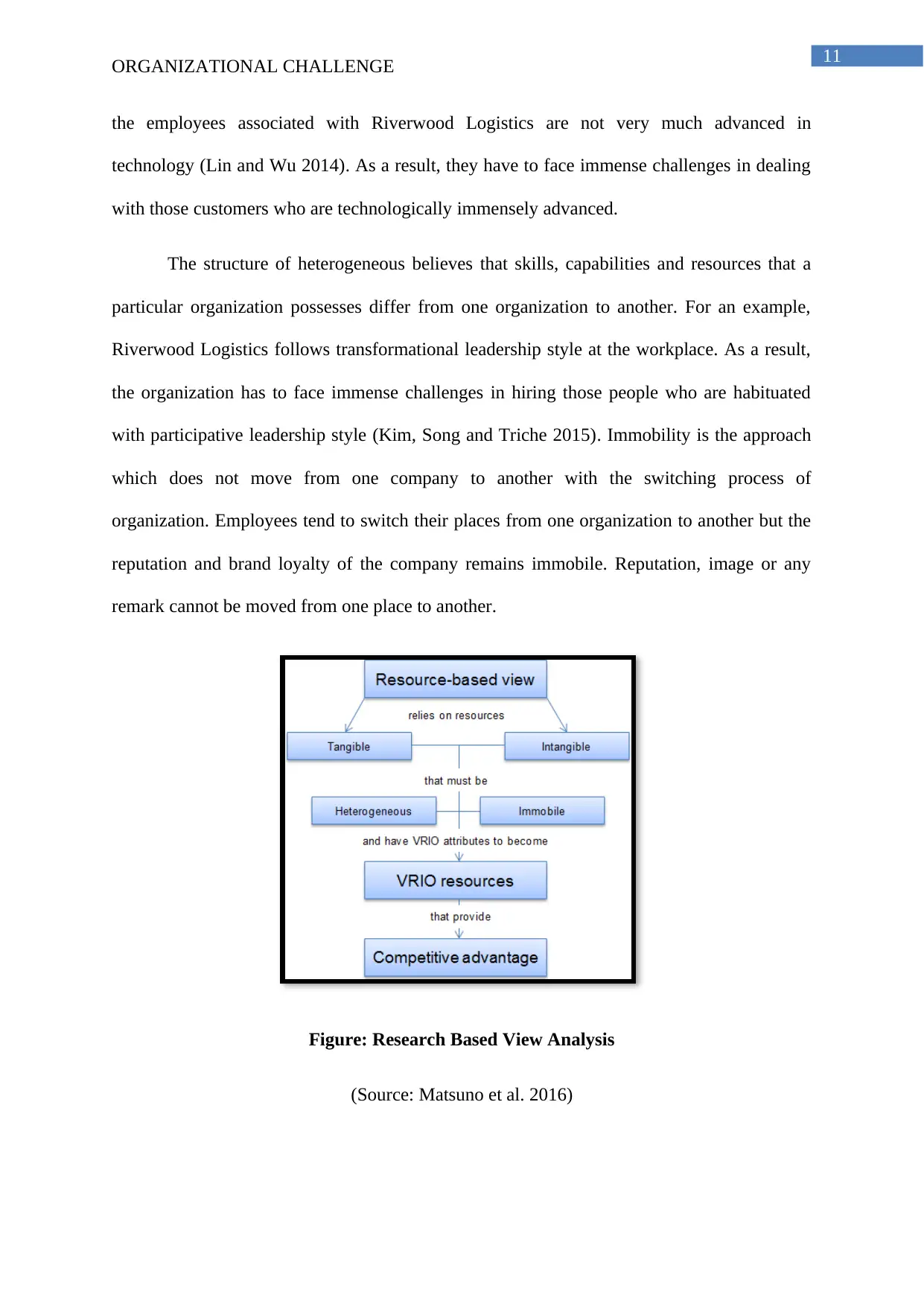
11
ORGANIZATIONAL CHALLENGE
the employees associated with Riverwood Logistics are not very much advanced in
technology (Lin and Wu 2014). As a result, they have to face immense challenges in dealing
with those customers who are technologically immensely advanced.
The structure of heterogeneous believes that skills, capabilities and resources that a
particular organization possesses differ from one organization to another. For an example,
Riverwood Logistics follows transformational leadership style at the workplace. As a result,
the organization has to face immense challenges in hiring those people who are habituated
with participative leadership style (Kim, Song and Triche 2015). Immobility is the approach
which does not move from one company to another with the switching process of
organization. Employees tend to switch their places from one organization to another but the
reputation and brand loyalty of the company remains immobile. Reputation, image or any
remark cannot be moved from one place to another.
Figure: Research Based View Analysis
(Source: Matsuno et al. 2016)
ORGANIZATIONAL CHALLENGE
the employees associated with Riverwood Logistics are not very much advanced in
technology (Lin and Wu 2014). As a result, they have to face immense challenges in dealing
with those customers who are technologically immensely advanced.
The structure of heterogeneous believes that skills, capabilities and resources that a
particular organization possesses differ from one organization to another. For an example,
Riverwood Logistics follows transformational leadership style at the workplace. As a result,
the organization has to face immense challenges in hiring those people who are habituated
with participative leadership style (Kim, Song and Triche 2015). Immobility is the approach
which does not move from one company to another with the switching process of
organization. Employees tend to switch their places from one organization to another but the
reputation and brand loyalty of the company remains immobile. Reputation, image or any
remark cannot be moved from one place to another.
Figure: Research Based View Analysis
(Source: Matsuno et al. 2016)
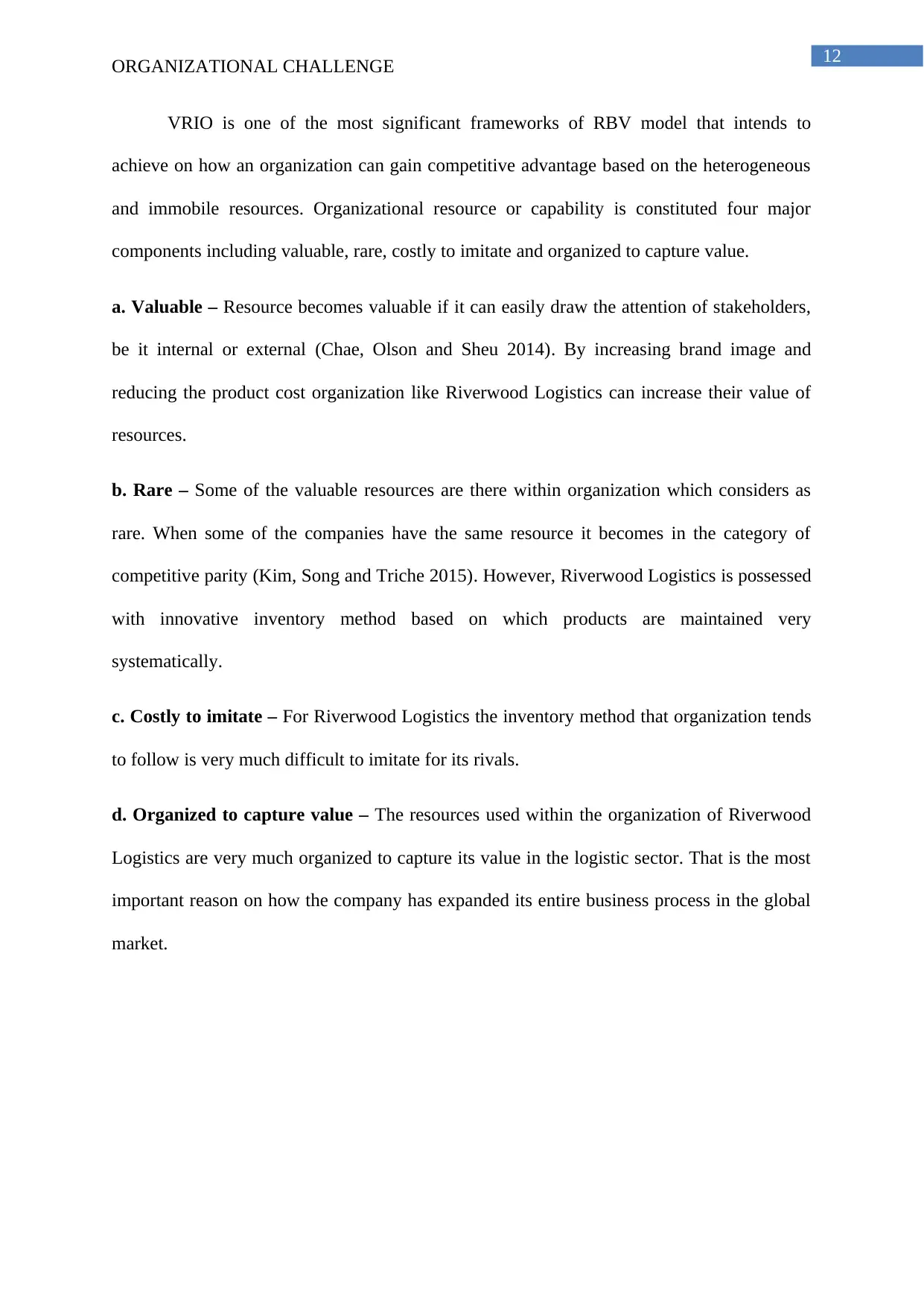
12
ORGANIZATIONAL CHALLENGE
VRIO is one of the most significant frameworks of RBV model that intends to
achieve on how an organization can gain competitive advantage based on the heterogeneous
and immobile resources. Organizational resource or capability is constituted four major
components including valuable, rare, costly to imitate and organized to capture value.
a. Valuable – Resource becomes valuable if it can easily draw the attention of stakeholders,
be it internal or external (Chae, Olson and Sheu 2014). By increasing brand image and
reducing the product cost organization like Riverwood Logistics can increase their value of
resources.
b. Rare – Some of the valuable resources are there within organization which considers as
rare. When some of the companies have the same resource it becomes in the category of
competitive parity (Kim, Song and Triche 2015). However, Riverwood Logistics is possessed
with innovative inventory method based on which products are maintained very
systematically.
c. Costly to imitate – For Riverwood Logistics the inventory method that organization tends
to follow is very much difficult to imitate for its rivals.
d. Organized to capture value – The resources used within the organization of Riverwood
Logistics are very much organized to capture its value in the logistic sector. That is the most
important reason on how the company has expanded its entire business process in the global
market.
ORGANIZATIONAL CHALLENGE
VRIO is one of the most significant frameworks of RBV model that intends to
achieve on how an organization can gain competitive advantage based on the heterogeneous
and immobile resources. Organizational resource or capability is constituted four major
components including valuable, rare, costly to imitate and organized to capture value.
a. Valuable – Resource becomes valuable if it can easily draw the attention of stakeholders,
be it internal or external (Chae, Olson and Sheu 2014). By increasing brand image and
reducing the product cost organization like Riverwood Logistics can increase their value of
resources.
b. Rare – Some of the valuable resources are there within organization which considers as
rare. When some of the companies have the same resource it becomes in the category of
competitive parity (Kim, Song and Triche 2015). However, Riverwood Logistics is possessed
with innovative inventory method based on which products are maintained very
systematically.
c. Costly to imitate – For Riverwood Logistics the inventory method that organization tends
to follow is very much difficult to imitate for its rivals.
d. Organized to capture value – The resources used within the organization of Riverwood
Logistics are very much organized to capture its value in the logistic sector. That is the most
important reason on how the company has expanded its entire business process in the global
market.
Paraphrase This Document
Need a fresh take? Get an instant paraphrase of this document with our AI Paraphraser
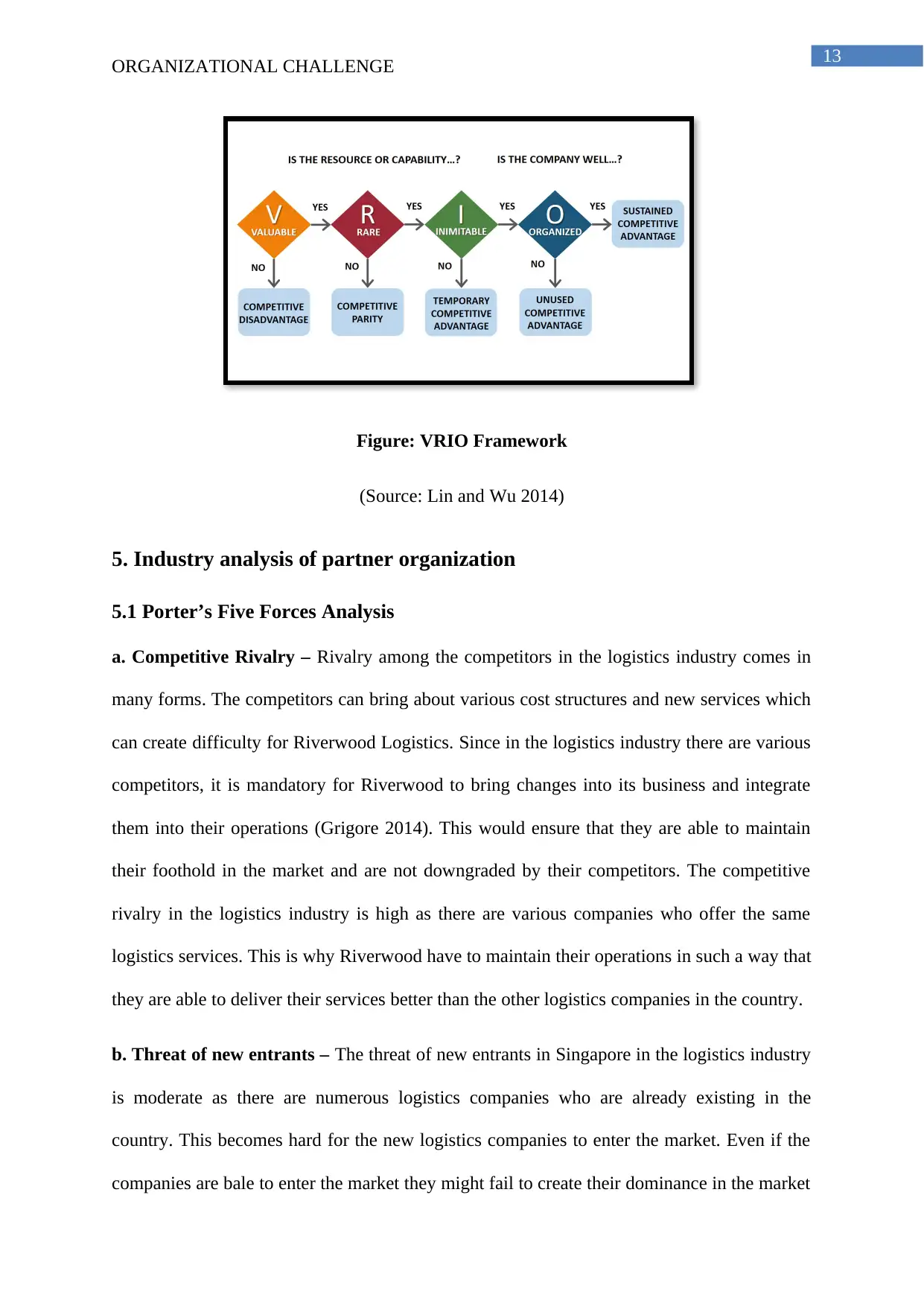
13
ORGANIZATIONAL CHALLENGE
Figure: VRIO Framework
(Source: Lin and Wu 2014)
5. Industry analysis of partner organization
5.1 Porter’s Five Forces Analysis
a. Competitive Rivalry – Rivalry among the competitors in the logistics industry comes in
many forms. The competitors can bring about various cost structures and new services which
can create difficulty for Riverwood Logistics. Since in the logistics industry there are various
competitors, it is mandatory for Riverwood to bring changes into its business and integrate
them into their operations (Grigore 2014). This would ensure that they are able to maintain
their foothold in the market and are not downgraded by their competitors. The competitive
rivalry in the logistics industry is high as there are various companies who offer the same
logistics services. This is why Riverwood have to maintain their operations in such a way that
they are able to deliver their services better than the other logistics companies in the country.
b. Threat of new entrants – The threat of new entrants in Singapore in the logistics industry
is moderate as there are numerous logistics companies who are already existing in the
country. This becomes hard for the new logistics companies to enter the market. Even if the
companies are bale to enter the market they might fail to create their dominance in the market
ORGANIZATIONAL CHALLENGE
Figure: VRIO Framework
(Source: Lin and Wu 2014)
5. Industry analysis of partner organization
5.1 Porter’s Five Forces Analysis
a. Competitive Rivalry – Rivalry among the competitors in the logistics industry comes in
many forms. The competitors can bring about various cost structures and new services which
can create difficulty for Riverwood Logistics. Since in the logistics industry there are various
competitors, it is mandatory for Riverwood to bring changes into its business and integrate
them into their operations (Grigore 2014). This would ensure that they are able to maintain
their foothold in the market and are not downgraded by their competitors. The competitive
rivalry in the logistics industry is high as there are various companies who offer the same
logistics services. This is why Riverwood have to maintain their operations in such a way that
they are able to deliver their services better than the other logistics companies in the country.
b. Threat of new entrants – The threat of new entrants in Singapore in the logistics industry
is moderate as there are numerous logistics companies who are already existing in the
country. This becomes hard for the new logistics companies to enter the market. Even if the
companies are bale to enter the market they might fail to create their dominance in the market
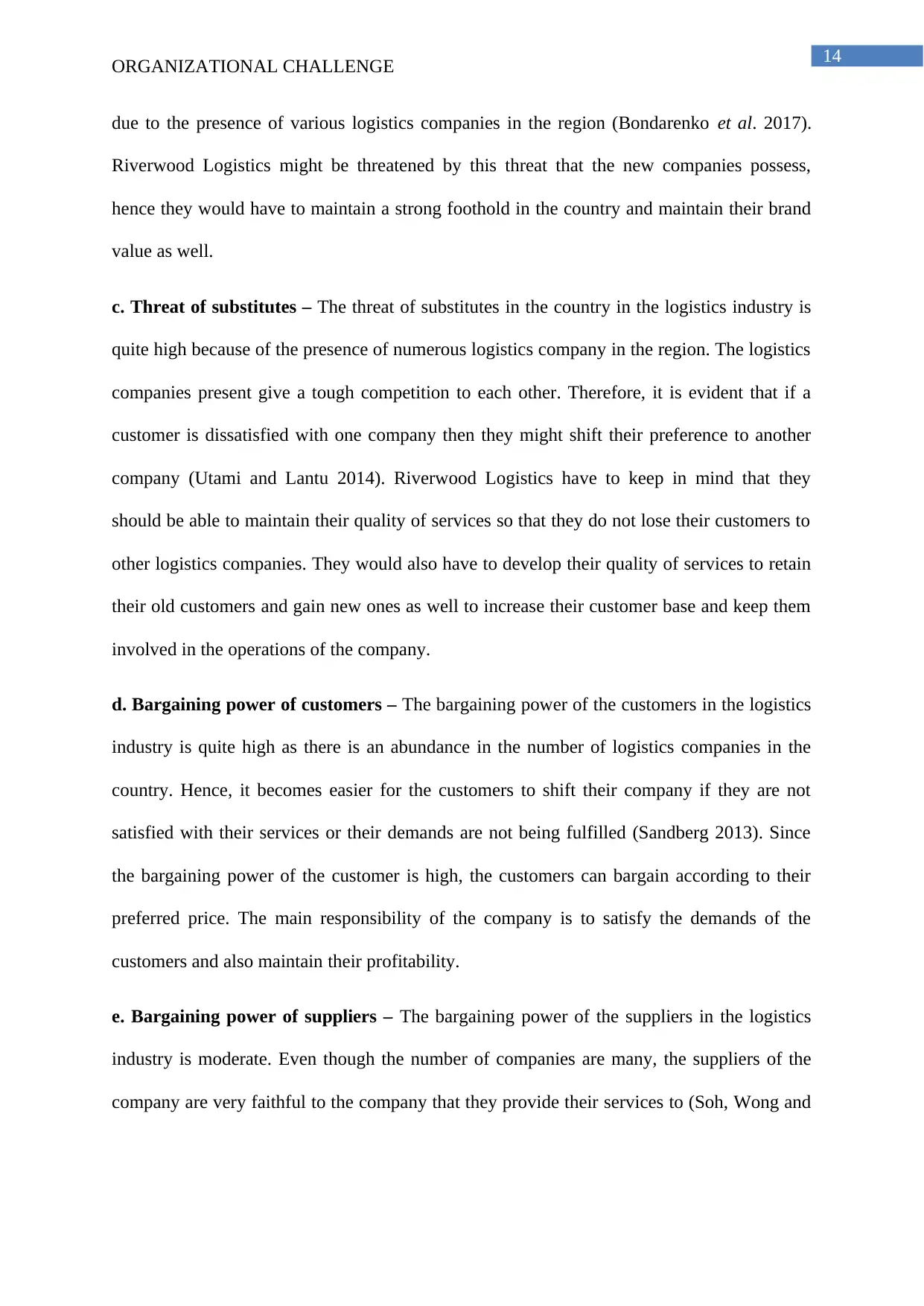
14
ORGANIZATIONAL CHALLENGE
due to the presence of various logistics companies in the region (Bondarenko et al. 2017).
Riverwood Logistics might be threatened by this threat that the new companies possess,
hence they would have to maintain a strong foothold in the country and maintain their brand
value as well.
c. Threat of substitutes – The threat of substitutes in the country in the logistics industry is
quite high because of the presence of numerous logistics company in the region. The logistics
companies present give a tough competition to each other. Therefore, it is evident that if a
customer is dissatisfied with one company then they might shift their preference to another
company (Utami and Lantu 2014). Riverwood Logistics have to keep in mind that they
should be able to maintain their quality of services so that they do not lose their customers to
other logistics companies. They would also have to develop their quality of services to retain
their old customers and gain new ones as well to increase their customer base and keep them
involved in the operations of the company.
d. Bargaining power of customers – The bargaining power of the customers in the logistics
industry is quite high as there is an abundance in the number of logistics companies in the
country. Hence, it becomes easier for the customers to shift their company if they are not
satisfied with their services or their demands are not being fulfilled (Sandberg 2013). Since
the bargaining power of the customer is high, the customers can bargain according to their
preferred price. The main responsibility of the company is to satisfy the demands of the
customers and also maintain their profitability.
e. Bargaining power of suppliers – The bargaining power of the suppliers in the logistics
industry is moderate. Even though the number of companies are many, the suppliers of the
company are very faithful to the company that they provide their services to (Soh, Wong and
ORGANIZATIONAL CHALLENGE
due to the presence of various logistics companies in the region (Bondarenko et al. 2017).
Riverwood Logistics might be threatened by this threat that the new companies possess,
hence they would have to maintain a strong foothold in the country and maintain their brand
value as well.
c. Threat of substitutes – The threat of substitutes in the country in the logistics industry is
quite high because of the presence of numerous logistics company in the region. The logistics
companies present give a tough competition to each other. Therefore, it is evident that if a
customer is dissatisfied with one company then they might shift their preference to another
company (Utami and Lantu 2014). Riverwood Logistics have to keep in mind that they
should be able to maintain their quality of services so that they do not lose their customers to
other logistics companies. They would also have to develop their quality of services to retain
their old customers and gain new ones as well to increase their customer base and keep them
involved in the operations of the company.
d. Bargaining power of customers – The bargaining power of the customers in the logistics
industry is quite high as there is an abundance in the number of logistics companies in the
country. Hence, it becomes easier for the customers to shift their company if they are not
satisfied with their services or their demands are not being fulfilled (Sandberg 2013). Since
the bargaining power of the customer is high, the customers can bargain according to their
preferred price. The main responsibility of the company is to satisfy the demands of the
customers and also maintain their profitability.
e. Bargaining power of suppliers – The bargaining power of the suppliers in the logistics
industry is moderate. Even though the number of companies are many, the suppliers of the
company are very faithful to the company that they provide their services to (Soh, Wong and
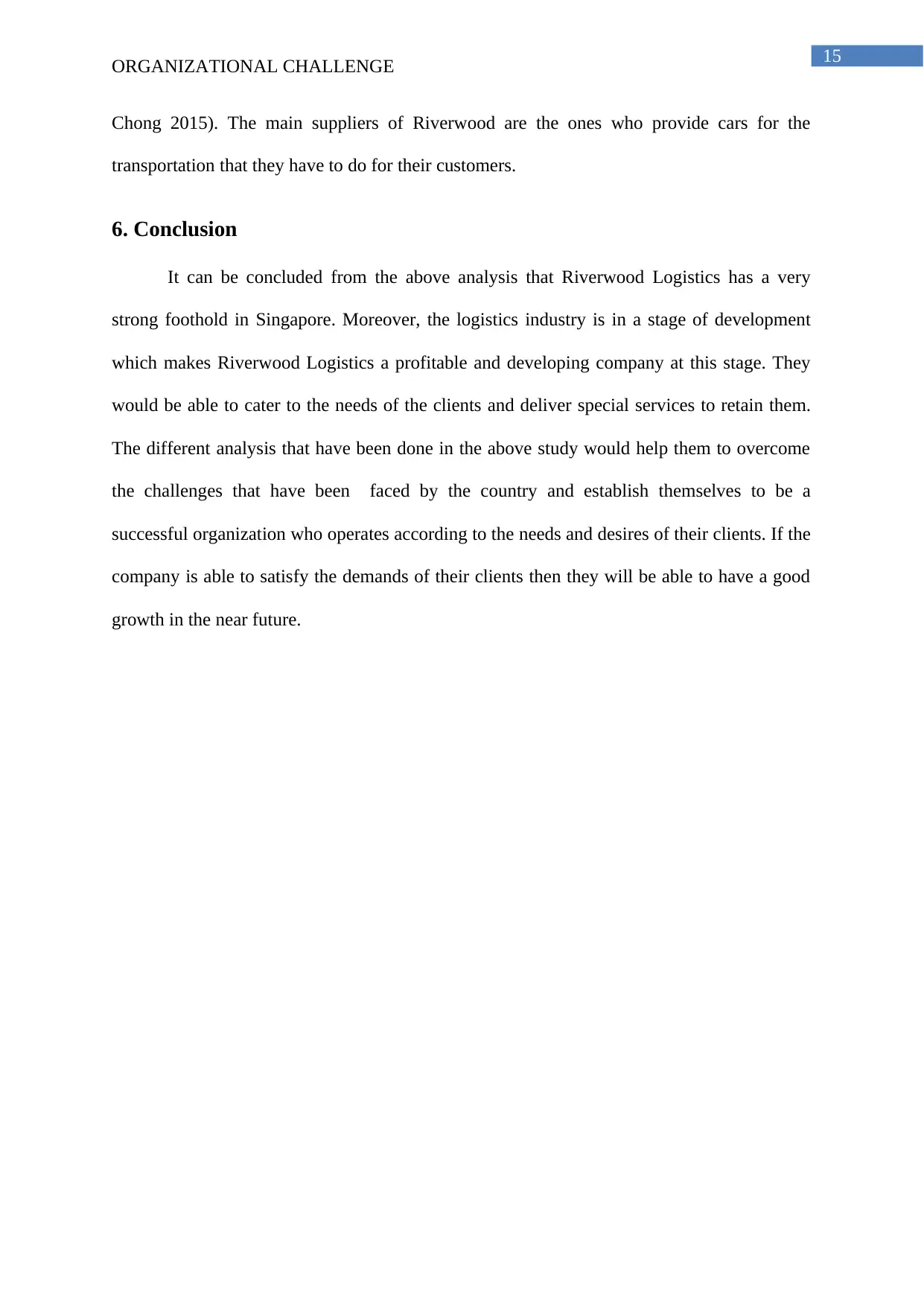
15
ORGANIZATIONAL CHALLENGE
Chong 2015). The main suppliers of Riverwood are the ones who provide cars for the
transportation that they have to do for their customers.
6. Conclusion
It can be concluded from the above analysis that Riverwood Logistics has a very
strong foothold in Singapore. Moreover, the logistics industry is in a stage of development
which makes Riverwood Logistics a profitable and developing company at this stage. They
would be able to cater to the needs of the clients and deliver special services to retain them.
The different analysis that have been done in the above study would help them to overcome
the challenges that have been faced by the country and establish themselves to be a
successful organization who operates according to the needs and desires of their clients. If the
company is able to satisfy the demands of their clients then they will be able to have a good
growth in the near future.
ORGANIZATIONAL CHALLENGE
Chong 2015). The main suppliers of Riverwood are the ones who provide cars for the
transportation that they have to do for their customers.
6. Conclusion
It can be concluded from the above analysis that Riverwood Logistics has a very
strong foothold in Singapore. Moreover, the logistics industry is in a stage of development
which makes Riverwood Logistics a profitable and developing company at this stage. They
would be able to cater to the needs of the clients and deliver special services to retain them.
The different analysis that have been done in the above study would help them to overcome
the challenges that have been faced by the country and establish themselves to be a
successful organization who operates according to the needs and desires of their clients. If the
company is able to satisfy the demands of their clients then they will be able to have a good
growth in the near future.
Secure Best Marks with AI Grader
Need help grading? Try our AI Grader for instant feedback on your assignments.
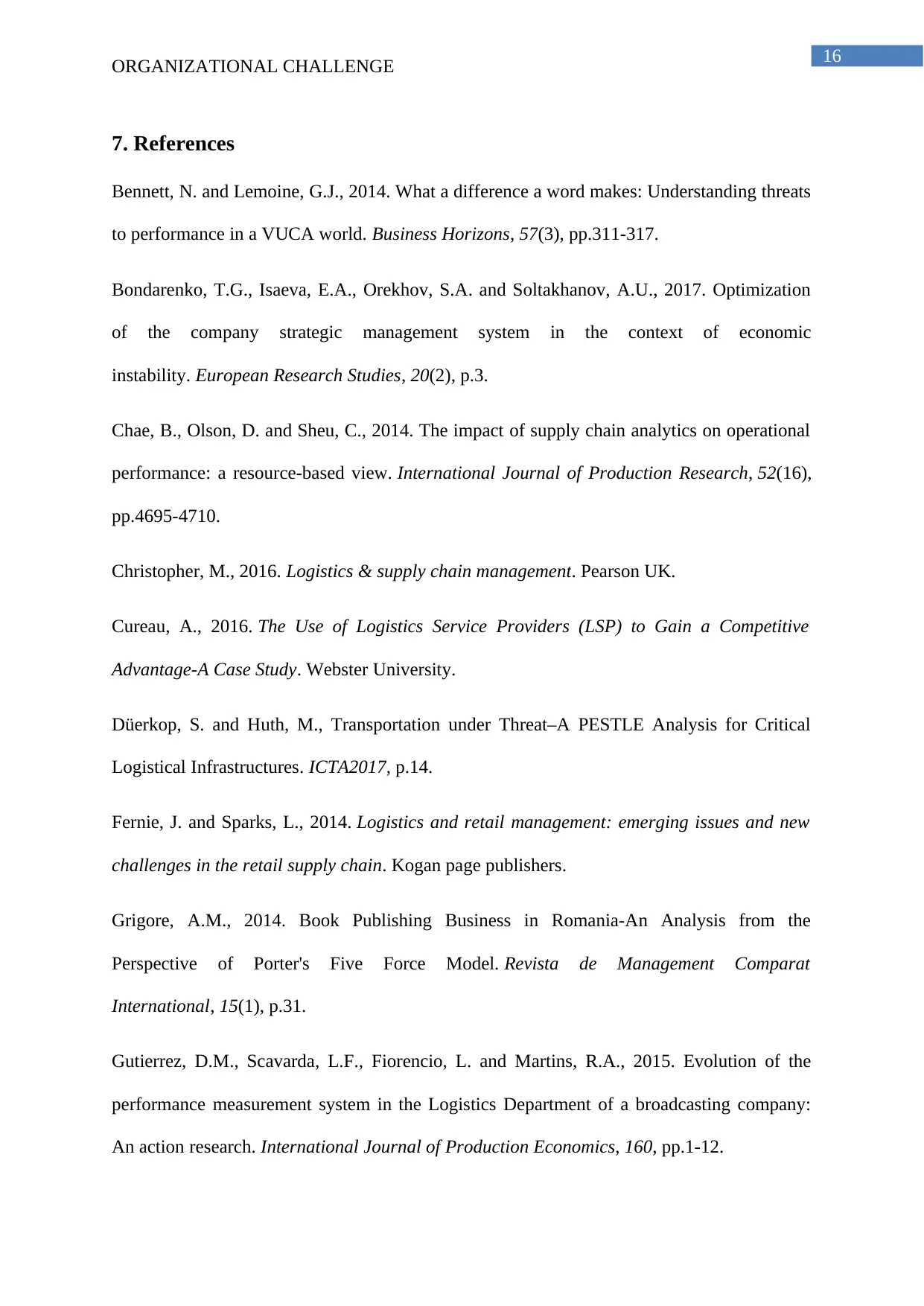
16
ORGANIZATIONAL CHALLENGE
7. References
Bennett, N. and Lemoine, G.J., 2014. What a difference a word makes: Understanding threats
to performance in a VUCA world. Business Horizons, 57(3), pp.311-317.
Bondarenko, T.G., Isaeva, E.A., Orekhov, S.A. and Soltakhanov, A.U., 2017. Optimization
of the company strategic management system in the context of economic
instability. European Research Studies, 20(2), p.3.
Chae, B., Olson, D. and Sheu, C., 2014. The impact of supply chain analytics on operational
performance: a resource-based view. International Journal of Production Research, 52(16),
pp.4695-4710.
Christopher, M., 2016. Logistics & supply chain management. Pearson UK.
Cureau, A., 2016. The Use of Logistics Service Providers (LSP) to Gain a Competitive
Advantage-A Case Study. Webster University.
Düerkop, S. and Huth, M., Transportation under Threat–A PESTLE Analysis for Critical
Logistical Infrastructures. ICTA2017, p.14.
Fernie, J. and Sparks, L., 2014. Logistics and retail management: emerging issues and new
challenges in the retail supply chain. Kogan page publishers.
Grigore, A.M., 2014. Book Publishing Business in Romania-An Analysis from the
Perspective of Porter's Five Force Model. Revista de Management Comparat
International, 15(1), p.31.
Gutierrez, D.M., Scavarda, L.F., Fiorencio, L. and Martins, R.A., 2015. Evolution of the
performance measurement system in the Logistics Department of a broadcasting company:
An action research. International Journal of Production Economics, 160, pp.1-12.
ORGANIZATIONAL CHALLENGE
7. References
Bennett, N. and Lemoine, G.J., 2014. What a difference a word makes: Understanding threats
to performance in a VUCA world. Business Horizons, 57(3), pp.311-317.
Bondarenko, T.G., Isaeva, E.A., Orekhov, S.A. and Soltakhanov, A.U., 2017. Optimization
of the company strategic management system in the context of economic
instability. European Research Studies, 20(2), p.3.
Chae, B., Olson, D. and Sheu, C., 2014. The impact of supply chain analytics on operational
performance: a resource-based view. International Journal of Production Research, 52(16),
pp.4695-4710.
Christopher, M., 2016. Logistics & supply chain management. Pearson UK.
Cureau, A., 2016. The Use of Logistics Service Providers (LSP) to Gain a Competitive
Advantage-A Case Study. Webster University.
Düerkop, S. and Huth, M., Transportation under Threat–A PESTLE Analysis for Critical
Logistical Infrastructures. ICTA2017, p.14.
Fernie, J. and Sparks, L., 2014. Logistics and retail management: emerging issues and new
challenges in the retail supply chain. Kogan page publishers.
Grigore, A.M., 2014. Book Publishing Business in Romania-An Analysis from the
Perspective of Porter's Five Force Model. Revista de Management Comparat
International, 15(1), p.31.
Gutierrez, D.M., Scavarda, L.F., Fiorencio, L. and Martins, R.A., 2015. Evolution of the
performance measurement system in the Logistics Department of a broadcasting company:
An action research. International Journal of Production Economics, 160, pp.1-12.
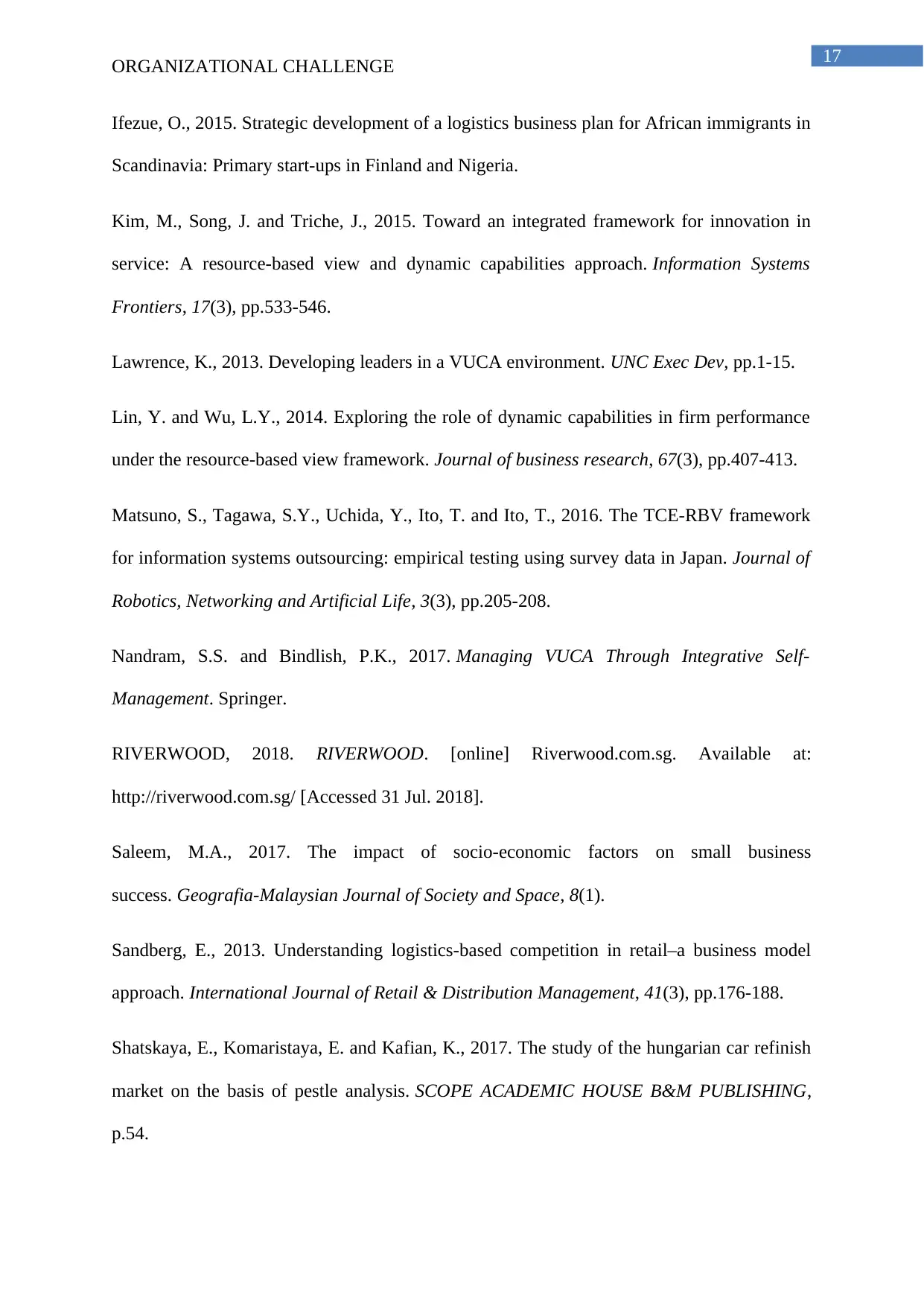
17
ORGANIZATIONAL CHALLENGE
Ifezue, O., 2015. Strategic development of a logistics business plan for African immigrants in
Scandinavia: Primary start-ups in Finland and Nigeria.
Kim, M., Song, J. and Triche, J., 2015. Toward an integrated framework for innovation in
service: A resource-based view and dynamic capabilities approach. Information Systems
Frontiers, 17(3), pp.533-546.
Lawrence, K., 2013. Developing leaders in a VUCA environment. UNC Exec Dev, pp.1-15.
Lin, Y. and Wu, L.Y., 2014. Exploring the role of dynamic capabilities in firm performance
under the resource-based view framework. Journal of business research, 67(3), pp.407-413.
Matsuno, S., Tagawa, S.Y., Uchida, Y., Ito, T. and Ito, T., 2016. The TCE-RBV framework
for information systems outsourcing: empirical testing using survey data in Japan. Journal of
Robotics, Networking and Artificial Life, 3(3), pp.205-208.
Nandram, S.S. and Bindlish, P.K., 2017. Managing VUCA Through Integrative Self-
Management. Springer.
RIVERWOOD, 2018. RIVERWOOD. [online] Riverwood.com.sg. Available at:
http://riverwood.com.sg/ [Accessed 31 Jul. 2018].
Saleem, M.A., 2017. The impact of socio-economic factors on small business
success. Geografia-Malaysian Journal of Society and Space, 8(1).
Sandberg, E., 2013. Understanding logistics-based competition in retail–a business model
approach. International Journal of Retail & Distribution Management, 41(3), pp.176-188.
Shatskaya, E., Komaristaya, E. and Kafian, K., 2017. The study of the hungarian car refinish
market on the basis of pestle analysis. SCOPE ACADEMIC HOUSE B&M PUBLISHING,
p.54.
ORGANIZATIONAL CHALLENGE
Ifezue, O., 2015. Strategic development of a logistics business plan for African immigrants in
Scandinavia: Primary start-ups in Finland and Nigeria.
Kim, M., Song, J. and Triche, J., 2015. Toward an integrated framework for innovation in
service: A resource-based view and dynamic capabilities approach. Information Systems
Frontiers, 17(3), pp.533-546.
Lawrence, K., 2013. Developing leaders in a VUCA environment. UNC Exec Dev, pp.1-15.
Lin, Y. and Wu, L.Y., 2014. Exploring the role of dynamic capabilities in firm performance
under the resource-based view framework. Journal of business research, 67(3), pp.407-413.
Matsuno, S., Tagawa, S.Y., Uchida, Y., Ito, T. and Ito, T., 2016. The TCE-RBV framework
for information systems outsourcing: empirical testing using survey data in Japan. Journal of
Robotics, Networking and Artificial Life, 3(3), pp.205-208.
Nandram, S.S. and Bindlish, P.K., 2017. Managing VUCA Through Integrative Self-
Management. Springer.
RIVERWOOD, 2018. RIVERWOOD. [online] Riverwood.com.sg. Available at:
http://riverwood.com.sg/ [Accessed 31 Jul. 2018].
Saleem, M.A., 2017. The impact of socio-economic factors on small business
success. Geografia-Malaysian Journal of Society and Space, 8(1).
Sandberg, E., 2013. Understanding logistics-based competition in retail–a business model
approach. International Journal of Retail & Distribution Management, 41(3), pp.176-188.
Shatskaya, E., Komaristaya, E. and Kafian, K., 2017. The study of the hungarian car refinish
market on the basis of pestle analysis. SCOPE ACADEMIC HOUSE B&M PUBLISHING,
p.54.
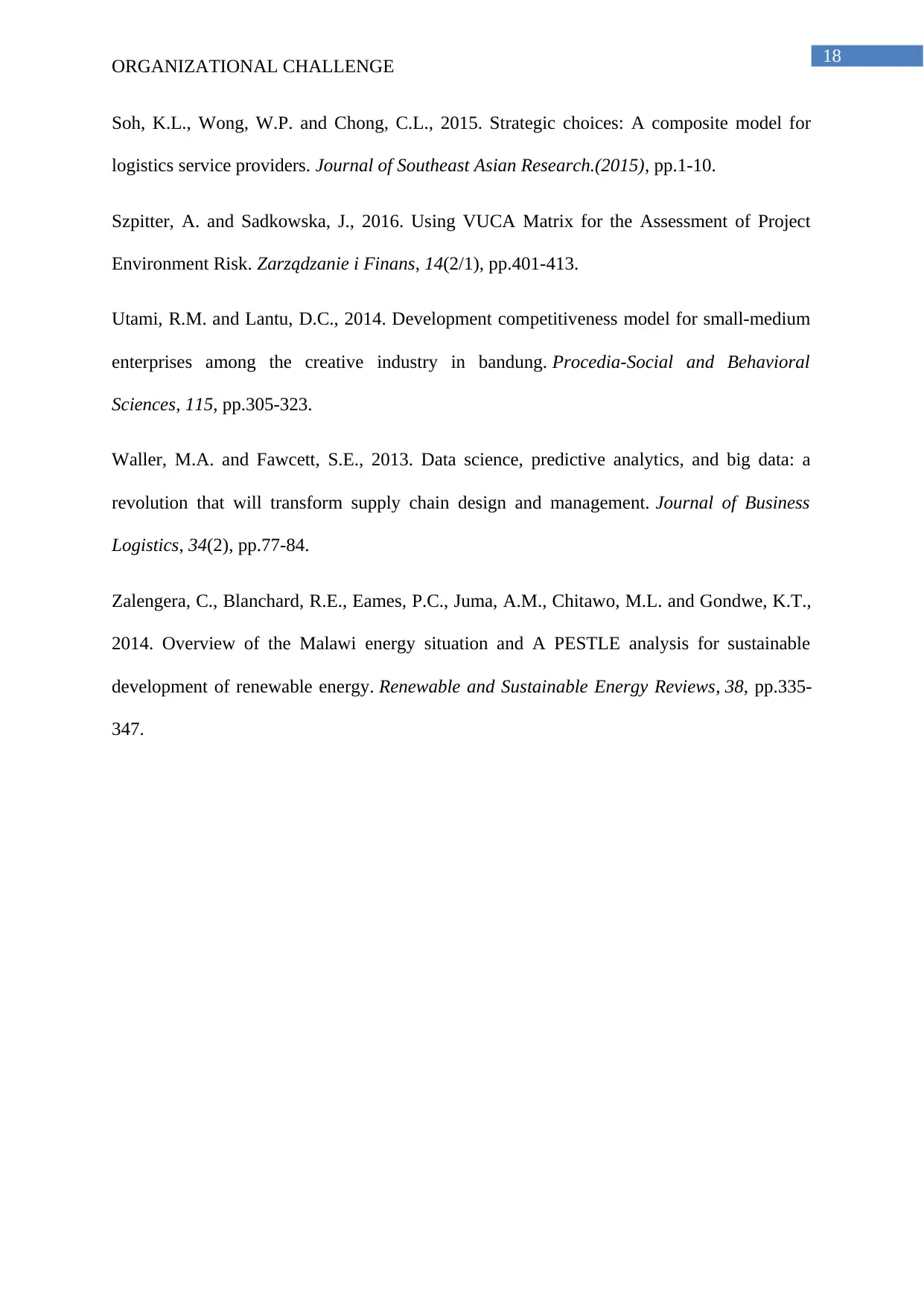
18
ORGANIZATIONAL CHALLENGE
Soh, K.L., Wong, W.P. and Chong, C.L., 2015. Strategic choices: A composite model for
logistics service providers. Journal of Southeast Asian Research.(2015), pp.1-10.
Szpitter, A. and Sadkowska, J., 2016. Using VUCA Matrix for the Assessment of Project
Environment Risk. Zarządzanie i Finans, 14(2/1), pp.401-413.
Utami, R.M. and Lantu, D.C., 2014. Development competitiveness model for small-medium
enterprises among the creative industry in bandung. Procedia-Social and Behavioral
Sciences, 115, pp.305-323.
Waller, M.A. and Fawcett, S.E., 2013. Data science, predictive analytics, and big data: a
revolution that will transform supply chain design and management. Journal of Business
Logistics, 34(2), pp.77-84.
Zalengera, C., Blanchard, R.E., Eames, P.C., Juma, A.M., Chitawo, M.L. and Gondwe, K.T.,
2014. Overview of the Malawi energy situation and A PESTLE analysis for sustainable
development of renewable energy. Renewable and Sustainable Energy Reviews, 38, pp.335-
347.
ORGANIZATIONAL CHALLENGE
Soh, K.L., Wong, W.P. and Chong, C.L., 2015. Strategic choices: A composite model for
logistics service providers. Journal of Southeast Asian Research.(2015), pp.1-10.
Szpitter, A. and Sadkowska, J., 2016. Using VUCA Matrix for the Assessment of Project
Environment Risk. Zarządzanie i Finans, 14(2/1), pp.401-413.
Utami, R.M. and Lantu, D.C., 2014. Development competitiveness model for small-medium
enterprises among the creative industry in bandung. Procedia-Social and Behavioral
Sciences, 115, pp.305-323.
Waller, M.A. and Fawcett, S.E., 2013. Data science, predictive analytics, and big data: a
revolution that will transform supply chain design and management. Journal of Business
Logistics, 34(2), pp.77-84.
Zalengera, C., Blanchard, R.E., Eames, P.C., Juma, A.M., Chitawo, M.L. and Gondwe, K.T.,
2014. Overview of the Malawi energy situation and A PESTLE analysis for sustainable
development of renewable energy. Renewable and Sustainable Energy Reviews, 38, pp.335-
347.
1 out of 19
Related Documents
Your All-in-One AI-Powered Toolkit for Academic Success.
+13062052269
info@desklib.com
Available 24*7 on WhatsApp / Email
![[object Object]](/_next/static/media/star-bottom.7253800d.svg)
Unlock your academic potential
© 2024 | Zucol Services PVT LTD | All rights reserved.





